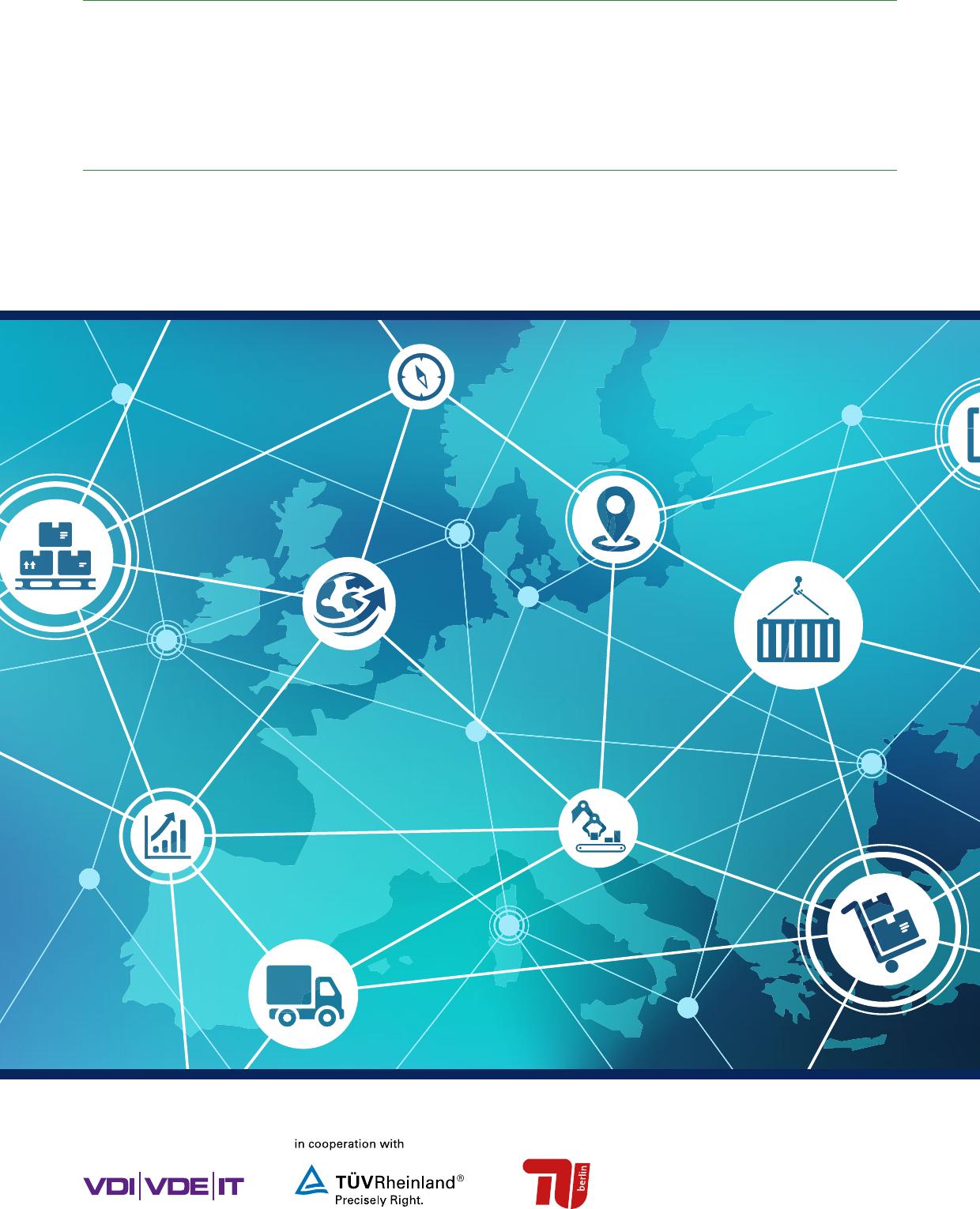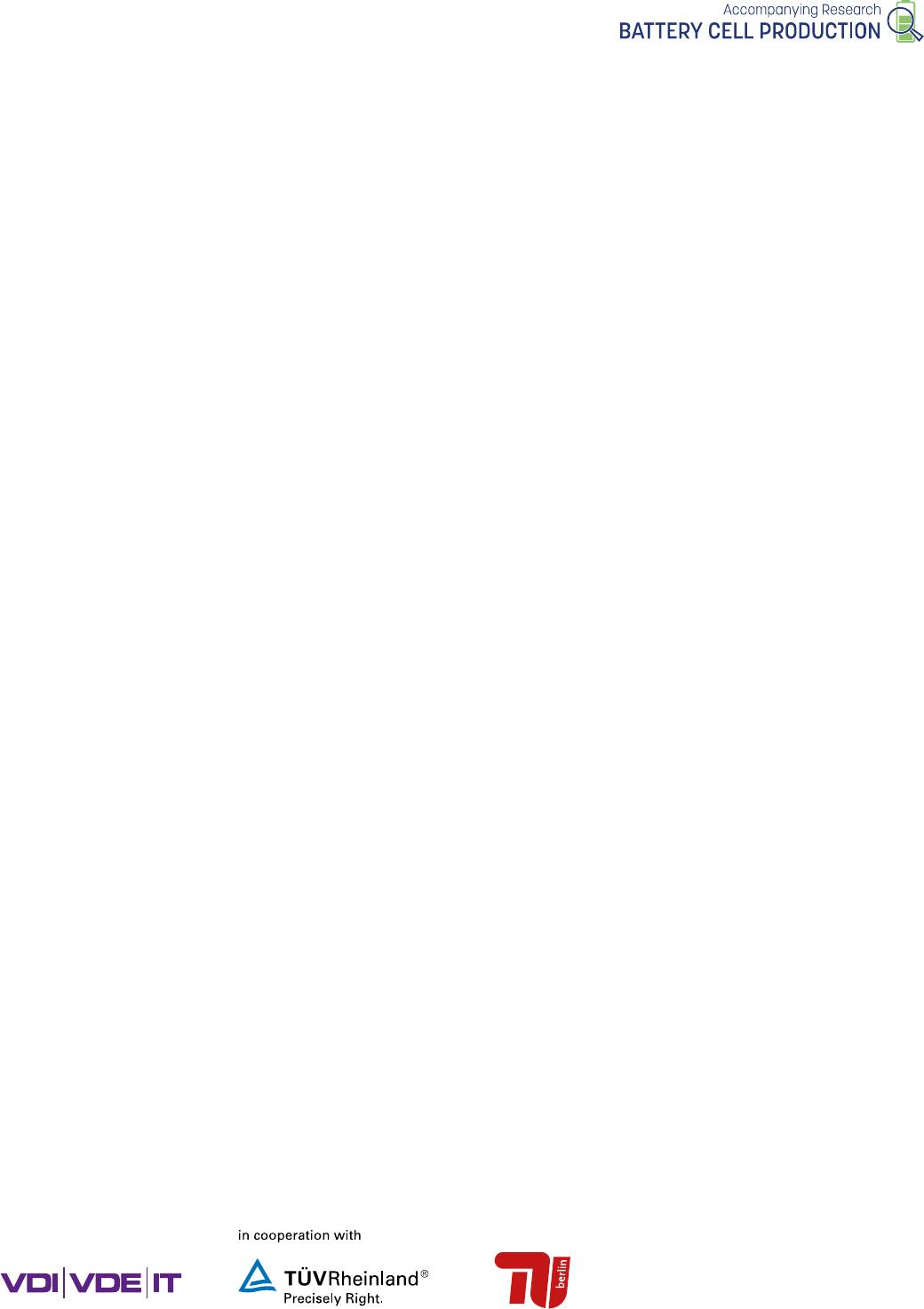ResilientSupplyChainsintheBatteryIndustryPublicationoftheaccompanyingresearchonbatterycellproductiononbehalfoftheGermanFederalMinistryforEconomicAffairsandClimateActionII/2023▪AnalysisPublisherVDI/VDEInnovation+TechnikGmbHSteinplatz110623BerlinAuthorsAikoBüntingChristophSprungFranzDietrichFraukeBierau-DelpontFrederikVorholtJan-HinrichGieschenJuliaKowalJulianMarscheiderKerstinZehbeMatthiasTrunkMichaelLükenMischaBechbergerNikolasOehl-SchallaRomanKorzynietzSezerSolmazStefanWolfStevenNeupertTabeaKirchhoferVeraBeermannEditorSandraGenschMiraMaschkeLayoutVDI/VDE-IT,Anne-SophiePiehlBerlin,March2023ImageCreditsCoverpage:j-mel/AdobeStock1TABLEOFCONTENTS1ExecutiveSummary...................................................................................................................................................22Batterycellmanufacturingsupplychains..................................................................................................................32.1Focusonfivebatteryrawmaterials................................................................................................................................................72.1.1Lithium................................................................................................................................................................................102.1.2Nickel..................................................................................................................................................................................122.1.3Manganese.........................................................................................................................................................................142.1.4Cobalt..................................................................................................................................................................................162.1.5Graphite..............................................................................................................................................................................183Countryandmarketconcentrationinminingandrefining........................................................................................203.1Lithium.........................................................................................................................................................................................213.2Nickel............................................................................................................................................................................................223.3Manganese....................................................................................................................................................................................233.4Cobalt............................................................................................................................................................................................243.5Graphite........................................................................................................................................................................................254Europeanvaluecreation..........................................................................................................................................264.1Rawmaterialextraction................................................................................................................................................................294.1.1Lithiumore/brine................................................................................................................................................................304.1.2Nickelore............................................................................................................................................................................304.1.3Manganeseore...................................................................................................................................................................304.1.4Cobaltore...........................................................................................................................................................................304.2Materialproduction......................................................................................................................................................................314.2.1Lithiumprecursors..............................................................................................................................................................314.2.2Nickelprecursors.................................................................................................................................................................314.2.3Manganeseprecursors........................................................................................................................................................314.2.4Cobaltprecursors................................................................................................................................................................324.2.5Graphiteprecursors............................................................................................................................................................32Excursus:tradedata......................................................................................................................................................................324.3Componentmanufacturing...........................................................................................................................................................384.3.1Precursorsforcathodeactivematerial...............................................................................................................................384.3.2Cathodeactivematerial......................................................................................................................................................384.3.3Anodeactivematerial.........................................................................................................................................................384.4Batterycellmanufacturing............................................................................................................................................................394.5Batteryrecycling............................................................................................................................................................................395Risksandmeasures..................................................................................................................................................415.1Potentialforownsupply...............................................................................................................................................................415.2Measures.......................................................................................................................................................................................42Tableoffigures................................................................................................................................................................45Listofabbreviations........................................................................................................................................................47Glossary..........................................................................................................................................................................48Appendix.........................................................................................................................................................................49ResilientSupplyChainsintheBatteryIndustry21EXECUTIVESUMMARYThetransformationoftheautomobileindustryinGermanyisessentialinordertoachievetheclimatepolicyobjectivesofthecoalitionagreement.15millionfullyelectricpassengervehiclesby2030istheestablishedgoal.ThistransformationprocessneedstobehighlydynamicifthedevelopmentintoEurope’sleadingmarketforelectromobilityistoberealised.Tosupporttheestablishmentofasustainableandcompetitivebatteryvaluechain,theEuropeanBatteryAlliance(EBA)wasfounded.Additionally,twoImportantProjectsofCommonEuropeanInterest(IPCEIs)wereapprovedbytheEuropeanCommissionin2019/2020torealisethegoalofhigh-capacityEuropeanbatteryproductionby2030.Providedthatallofthebatterycellprojectsthathavebeenannouncedareimplemented,mostoftheEuropeanautomobileindustry’sdemandcouldbecoveredinEuropebytheyear2030.Alargeproportionofvaluecreationandtheperformanceofanelectricvehiclearetiedtothebattery.However,Europeishighlydependentonbatterycellimportstoday.NoneoftherawmaterialsrequiredforbatterycellmanufacturingarecurrentlyminedinsignificantquantitiesinEurope.Europeisthereforehighlydependentontheimportofmineralrawmaterials.Theglobaldynamicsinthedevelopmentofcellmanufacturingcapacitieswillleadtoneworworseningdependenciesandshortages,especiallyregardingthesupplyofmaterials.Inaddition,Europelackssufficientcapacitiesforfurtherprocessing.NotwithstandingtheincreaseinrecyclingandEuropeanrawmaterialprojectsthathavebeenannounced,thisimportdependencywillremainlargelyunchangedby2030accordingtonumerousexperts.Forexample,100%ofthelithiumforbatteryapplicationsisimportedtoday.EvenifEuroperealisestherawmaterialandrefiningprojectsthathavebeenannouncedtodate,Europewouldonlybeabletomineabout25%ofitsownlithiumdemandandrefineabout50%oftheneededintermediatelithiumproductsin2030.Thesituationissimilarforthesupplyofnickel,manganese,cobaltandgraphiteforbatterycellmanufacturing.AEuropeanself-sufficiencywithrawmaterialswillnotbepossible.Europeremainsdependentoninternationalcooperationtosecurethesupplyofmetalsforbatteries.Againstthebackgroundofrisinginternationaltensions,resilientsupplychainsarethusbecomingmoreimportant.ItisthereforetremendouslyimportantforcompaniesintheEuropeanbatteryecosystemtodiversifytheirsupplychains.Influenceonthesupplychaincanbeincreasedthroughpartnershipsanddirectinvestments.Geopoliticalrisksalsohavetobere-evaluated.WiththeCriticalRawMaterialsAct,theEuropeanCommissionisaccountingforgeopoliticalchangesandthere-evaluationofrawmaterialspolicy.Onlytherecyclingeconomywillofferawayoutoftherawmaterialdependencyinthelongterm.However,thecyclehastobefilledwithrawmaterialsbeforethetransitiontoacirculareconomycansucceed.Batterycellmanufacturingsupplychains32BATTERYCELLMANUFACTURINGSUPPLYCHAINSWorldwideexportsofgoodsaccountedformorethanone-fifthoftheglobalgrossdomesticproduct(GDP)in2020.1Thisenormousmagnitudeofinternationaltradeisakeycharacteristicofglobalisationand,amongotherthings,requirescloselymeshedsupplychainsspanningtheglobe.Thankstotoday’sglobalnetworking,productionprocessescanbebrokendownandlocatedinanyregionaroundtheworld.Economicbenefitsarisingfromcostdifferences,theavailabilityofproductionfactorsandafavourableinvestmentclimatecanthusberealised.ThecurrentdisruptionsofproductionprocessesandcommodityflowsduetotheCOVID-19pandemicaswellasgeopoliticalconflictsillustratehowdrastictherisksareforacomplexsupplychainwhichisbasedonademand-synchronisedproduction.Companiesareoftenabletorespondintheshortandmediumtermtoalleviatetheconsequencesofsupplybottlenecksandimplementsafeguards,suchasobtaininginsurance,increasinginventorylevelsorconcludingcontractswithemergencysuppliers.However,long-termriskminimisationbyadaptingthesupplychainstrategyisgenerallyassociatedwithhighercostsforcompanies.Sincetheglobaldivisionoflabouralongthevaluecreationstageshasbecometremendouslygeographicallyconcentratedthereductionofriskreductionistosomeextenthardlypossible.Withregardtothebatterycellmanufacturingvaluechain,manystepssuchastherecyclingofcertainrawmaterialsorcathodeandanodeproductionarehighlyconcentratedinChina.Ahighconcentrationisinpartfoundatthecompanylevelaswell.Thenumberofexistingsuppliersforsomegoodsissmall.2Theseoligopoliescanbecomeapotentialproblem,especiallywhenthegoodsindemandcannotbesubstitutedatareasonablecost.Asaresult,optionsfor1FederalAgencyforCivicEducation(2021):“EntwicklungdesgrenzüberschreitendenWarenhandels”(Developmentofthecross-bordertradeingoods).Online:https://www.bpb.de/kurz-knapp/zahlen-und-fakten/globalisierung/52543/entwicklung-des-grenzueberschreitenden-warenhandels/(Lastaccessedon:30November2022)2Deloitte(2021):“GlobaleLieferketten–KommteszueinemReshoring?”(Globalsupplychains–areweheadedforareshoring?)Online:https://www2.deloitte.com/ch/de/pages/consumer-industrial-products/articles/globale-lieferketten-kommt-es-zu-einem-reshoring.html(Lastaccessedon:30November2022)3Deloitte(2021):“GlobaleLieferketten–KommteszueinemReshoring?”(Globalsupplychains–areweheadedforareshoring?)Online:https://www2.deloitte.com/ch/de/pages/consumer-industrial-products/articles/globale-lieferketten-kommt-es-zu-einem-reshoring.html(Lastaccessedon:30November2022)4Caporaletal.(2019):TheWTOataCrossroad.Centerforstrategic&internationalstudies(CSIS).Online:https://www.wita.org/wp-content/up-loads/2019/09/190918_Caporal-et-al_WTOCrossroad_WEB_v2.pdf:(Lastaccessedon:12December2022)5FederalAgencyforCivicEducation(2017):WTO-WorldTradeOrganization.Online:https://www.bpb.de/kurz-knapp/zahlen-und-fakten/globalisi-erung/52802/wto-world-trade-organization/(Lastaccessedon14December2022)thediversificationofprocurementareinpartverylimited,meaningthatcompaniesonthedemandsidehavefewoptionsforreducingtheirdependency.Inthecontextofbatterycellmanufacturing,thisappliestocertainrawmaterials,suchasprimarylithiumextraction,cobalt,nickelandbatterygraphite.However,thefreetradehasbeenshowingsignsofweaknessforsometime.Internationaltradehasonlygrownslowlysincethe2008/2009financialcrisisandmoregovernmentscriticalofglobalisationhavecometopower.3Furthermore,theWorldTradeOrganisation(WTO)initsroleastheorganiserofworldtradehasbeenweakenedbynumerousinternalandexternalconflicts(seeINFOBOX:GoalsoftheWorldTradeOrganisation).4Conflictsarethereforemorelikelytointerferewithinternationaltraderelations.Itappearsthattheeraoftradethatislargelydetachedfrompoliticalinfluence,whichfollowsdefinedrulesandoptimisessupplychainsaccordingtocapitalistlogic,isdrawingtoacloseforthetimebeing.Ashiftfromarule-basedsystemwithequalrightstoapower-basedtraderegimeislooming.Thisdevelopmentgeneratesnewrisksforinternationaltradeandincreasestheneedformoreresilientsupplychains.Thementionedtrendisexpectedtoresultingreaterpoliticalinterventionintradematters.GoalsoftheWorldTradeOrganisation:Liberalisationofthemarkets,theloweringofdutiesandthecreationofaworldtradeorder.SinceAugust2016,theWTOhas164membersaccountingforabout98percentoftheworldwidetradeingoods.5TheAppellateBodyastheWTO'spermanentarbitratorhasbeenwithoutaquorumsinceDecember2019.AdecisiontoreformtheWTOwasreachedatthe12thWTOConferenceofMinistersResilientSupplyChainsintheBatteryIndustry4inJune2022,withtheintenttore-establishafunctioningAppellateBodywithintwoyears6.MeanwhiletheEUhasimplementedaninterimsolutionincooperationwith15otherWTOmembers.TheabilityoftheWTOtoamicablyresolvetradedisputesneverthelesscontinuestoerode.ThedevelopmentofthebatteryindustryispoliticalThereisahighconcentrationofbatteryindustryproductioncapacitiesinEastAsia,especiallyinChina.Thisisduetotheregionalaccumulationofbatteryproductionforelectronicconsumergoodsandtheresultingformationofanindustrialecosystem.Withtheriseofelectricvehiclesandintensivegovernmentsupport,theregionalbatteryindustryquicklyscaleduptocoverthedemandforvehiclebatteries.ThishighconcentrationcausestechnologydependenciesandreducestheresilienceoftheEuropeanautomobileindustry.Consequently,subsidypolicymeasureswithsteeringeffectswereimplementedinotherworldregionsinordertoboosttheproductionofelectricvehiclesanddiversifythemarket.ExaminedbelowarethegovernmentinterventioninChina,EuropeandtheUSA,whichrepresenttheleadingsalesmarketsforelectricvehiclesin2021,inthisorder.China:ElectromobilityandthebatteryindustryhavebeensupportedbythegovernmentinChinaforalongtime.Todaythecountryhasthelargestsalesmarketthankstosubsidiesforelectricvehicles,whichfavouredarapidexpansionofthemanufacturingbaseinChinaoverthelasttenyears.BatterycellmanufacturinginChinaalsoexpandedsignificantlyduringthistime.Chinesecellmanufacturerscurrentlyhavetheworld‘shighestcellmanufacturingcapacitiesbyfar.Theirshareoftheglobalmarketwasaround70%in2021.7Chinesecompaniesalsodominatemanyothersegmentsofthevaluechain,suchascomponentmanufacturingorthesupplychainsforrelevantrawmaterialssuchaslithium,cobalt,nickelandespeciallygraphite.InOctober2020ChinaannouncedthegoalthatNEVs(BEV,PHEVandFCEV)willaccountfor20%ofnewpassengervehiclesalesin2025.8Chinaisemployingvariouspolitical6WorldTradeOrganization(2022):MemberswelcomeMC12commitmenttoaddressdisputesettlement.Online:https://www.wto.org/english/news_e/news22_e/dsb_30jun22_e.htm(Lastaccessedon:14December2022)7SNEResearch(2022):ProductionCapacityofGlobalEVBatteryMakersForecastedtoReach8,247GWhin2030.Online:https://www.sneresearch.com/en/insight/release_view/17/page/12(Lastaccessedon:12December2022)8ICCT(2021):AGLOBALCOMPARISONOFTHELIFE-CYCLEGREENHOUSEGASEMISSIONSOFCOMBUSTIONENGINEANDELECTRICPASSENGERCARS(Lastaccessedon:12December2022)9IEA(2022):ElectricVehicleOutlook2022.Online:https://iea.blob.core.windows.net/assets/ad8fb04c-4f75-42fc-973a-6e54c8a4449a/GlobalElectricVehicleOutlook2022.pdf(Lastaccessedon:12December2022)10https://chinadialogue.net/en/digest/china-ends-electric-vehicle-subsidies/(Lastaccessedon:12December202211COM(2018)293final:EUROPEONTHEMOVE–SustainableMobilityforEurope:safe,connectedandcleanANNEX2“StrategicActionPlanonBatter-ies”toolstoacceleratetheelectrificationoftransportationandreachthetargetNEVpercentage,includingaflexibletaxpolicyandsubsidies.With3.3millionelectricpassengervehicles(BEVandPHEV),considerablymorevehiclesweresoldinChinain2021thaninEurope,where2.3millionvehiclesweresoldinthesameyear9.AccordingtoCAAM(ChinaAssociationofAutomobileManufacturers),theshareofNEVsinnewregistrationsexceededthetargetsetfor2025alreadyinthefirsthalfof2022.TheChinesegovernmentisnolongersubsidisingelectricvehicle(EV)buyerseffectiveonJanuary1st,2023.SomemeasurestosupportEVsalesremaininplace,forexampleEVbuyerscanclaimatenpercentVATexemptionuntiltheendof2023.Also,thecreditsystemforenvironmentallyfriendlycarsthatestablishesannualcompliancerequirementsforautomobilemanufacturersremains.CompaniesthatexceedtheEVproportiontargetintheirvehiclefleetcansellexcesscredits,whilethosethatfallshorthavetobuycreditsorpayafine.10Europe:TheEUdeemthepromotionofdevelopingaEuropeanbatteryindustryastrategicnecessaryandviewsbatteriesasakeytechnologytoensurethecompetitivenessofitsautomobileindustry.Therefore,theEUispursuingthegoalestablishedintheindustrialpolicystrategytorestoreEurope‘spositionasaleaderinakeyindustrythatisfitforthefuture.Thispromotesbothemploymentandgrowthwithintherecyclingeconomy,aswellasensuringcleanmobility,ahealthierenvironmentandbetterqualityoflifeforEUcitizens.11ThegoalistosupplytheEuropeanautomobileindustrywithsustainablyproducedbatteriesby2030AsecondaspectistostrengthentheautomobileindustrybyestablishinganinnovativeEuropeanbatteryecosystem,inwhichcompaniesandresearchinstitutionstransferinnovationsfromresearchtoproduction.Moreover,thedependencyonimports,especiallyinthevehiclebatterysegmenthastobereduced.Thesemeasuresdonotexcludenon-Europeanstakeholdersfromthedomesticmarketperse–neitherregardingfinancialsubsidiesnorthroughregulation.Batterycellmanufacturingsupplychains5WiththeImportantProjectofCommonEuropeanInterest(IPCEI)fundinginstrument,twolarge-scaleprogrammeswerelaunchedin2019and2021fortheestablishmentofasustainablebatteryvaluechaininEuropewithafundingvolumeof3.2and2.9billioneuros,respectively.12TheEUCommissionplacedgreatemphasisonconformitywiththeWTOrulesindesigningthesefundinginstruments.Thatissignificantbecausethismarket-orientedfundinghastorangeinthelimitsgivenbyWTOrulesregardingthepermissiontosupporttheindustry.Inaddition,regulationsarealsobeingpreparedintheEUaimingtosignificantlyincreaseanddiversifythesupplyofcriticalrawmaterials,tostrengthentherecyclingeconomy,andtosupportresearchandinnovation.TheEuropeanBatteryRegulationwillensurecompliancewithespeciallystrictsustainabilityrequirementsforbatteries/batterycellsproducedandtradedinEurope.13Aregulationtosafeguardthesupplyofcriticalrawmaterials,therebyreducingtheEU’sstrategicdependencies,isbeingsoughtthroughtheEuropeanCriticalRawMaterialsAct.14TheEUmemberstateshavealsoagreedonanewEUSupplyChainLawonDecember1st,2022.Itwillrequirecompaniestoexercisediligencewithregardtosocialandecologicaleffectsintheentiresupplychain,includingtheirownbusinessarea.15USA:SeverallawshavebeenpassedintheUSAsince2021,jointlyearmarkingseveralhundredbillionUSdollarsforclimateprotection,thetransformationoftheenergysupply,andinfrastructuredevelopmentandexpansion.Thiswillbenefitthebatteryindustryalongtheentirevaluechainaswellaselectricvehiclemanufacturers.Forexample,theBipartisanInfrastructureLaw16provided2.8billionUSdollarsinOctober2022tosupportdomesticcommercialenterprisesfortheextractionandprocessingoflithiumandgraphiteandforbatterymanufacturing.InMarch2022,theUSPresidentwithreferencetotheDefenceProductionAct(DPA)authorisedtheDepartmentofDefence(DoD)toboost12EuropeanCommissionannouncements.Online:https://ec.europa.eu/commission/presscorner/detail/en/ip_19_6705andhttps://ec.europa.eu/com-mission/presscorner/detail/en/IP_21_226(Lastaccessedon:30November2022)13EUParliament(2022):NewEUrulesformoresustainableandethicalbatteries.Online:https://www.europarl.europa.eu/news/en/headlines/econo-my/20220228STO24218/new-eu-rules-for-more-sustainable-and-ethical-batteries(Lastaccessedon:30November2022)14EUCommission(2022):EuropeanCriticalRawMaterialsAct.Online:https://ec.europa.eu/info/law/better-regulation/have-your-say/initia-tives/13597-European-Critical-Raw-Materials-Act_en(Lastaccessedon:30November2022)15DeutschePresse-Agentur(2022):“EU-StaateneinigbeiLieferkettengesetz”(EUstatesagreeonsupplychainlaw).Online:https://europeannewsroom.com/de/eu-staaten-einig-bei-lieferkettengesetz/(Lastaccessedon:14December2022)16PresidentBiden’sBipartisanInfrastructureLaw.Online:https://www.whitehouse.gov/bipartisan-infrastructure-law/(Lastaccessedon:30November2022)17InflationReductionActof2022.Online:https://www.congress.gov/bill/117th-congress/house-bill/5376/text(Lastaccessedon:30November2022)18Reuters(2022):Explainer:WhytheU.S.InflationReductionActhasEuropeupinarms.Online:https://www.reuters.com/markets/why-us-inflation-re-duction-act-has-europe-up-arms-2022-11-30/(Lastaccessedon:1December2022)19EUseekschangesto‘discriminatory’U.S.InflationReductionAct.Online:https://www.cbtnews.com/eu-seeks-changes-to-discriminatory-u-s-infla-tion-reduction-act/(Lastaccessedon:1December2022)theextractionandprocessingofimportantmaterialsforthelargebatterysupplychaininthecountry.Additionally,theUSCongresspassedthegreatestclimatelawinourcountry’shistoryinthesummerof2022,theso-calledlawforthereductionofinflation.17TheInflationReductionAct(IRA)earmarks368billionUSdollars,amongotherthingstopromotecleanenergygeneration,emission-freevehiclesandcleanindustrialprocessesaswellasmanufacturingmethods.Accordingtothecurrentform,thelawcallsfortaxcreditsofupto50%forautonomousenergystorageand7,500USdollarsforemission-freevehicles.Taxcreditsforthedomesticproductionandsaleofqualifiedcomponentssuchasbatteriesarealsoprovided.Theimposedrestrictions,forinstanceincaseofgrantingtaxcreditsforelectricvehicles,appeartobeprotectionistandcauseresentmentinternationally.Amongotherthings,itispresumedthatfinalproductionofthevehicleswilltakeplaceinNorthAmericaandthattheirtractionbatteriesaremadeusingcomponentsfromcertaincountries.Around200billioneuros(207billiondollars)oftheIRA’stotalfundingvolumeistiedtoprovisionsregardinglocallyproducedcontent,whichintheEU’sopinionmayviolatetherulesoftheWorldTradeOrganisation(WTO).18However,theEUisnottheonlyorganisationspeakingoutagainstthenewlaw.Chinahascriticisedthenewlawandthreatenedtotakeunspecifiedstepstoprotectitsinterestsagainstthe“discriminatory”law.SouthKoreaalsofearsthatitsautomobilemanufacturerswillnotbenefitfromtheUStaxbreaks.19DemandforbatterieswillmultiplyInviewofthemarketvolumeanditsexpectedgrowth,substantialpolitico-economicstepstoguidethedevelopmentandexpansionofthebatteryindustryobviouslyhavetobetaken.Theglobalmarketforlithium-ionbatteries(LIB)hasbeenestimatedataroundUSD42billionin2021.McKinseyanalystsexpectagrowthofmorethan20%annuallyuntilResilientSupplyChainsintheBatteryIndustry62030,reachingatleast360billiondollarsgloballybytheendofthedecade.20AccordingtoAdamasIntelligence,thebatterycapacityinstalledinallnewelectricvehiclesforpassengertransportationwhichwassoldworldwideinthefirstsixmonthsof2022increasedby79%year-on-yeartoatotalofnearly200GWh.21Theresearchandadvisoryservice’smarketanalysisshowsthattheglobalproductioncapacitiesofcellmanufacturerscouldincreasefromaround600GWh/acurrentlytomorethan6,000GWh/aby2030ifprojectsthathavebeenannouncedarefullyrealised.DuetotherisingdemandforandproductionofLIBs,start-upsareappearinginthesupplychainalongsideestablishedbatterycellsuppliers.Atthesametime,automobileindustryOEMsarediversifyingtheirsuppliers,increasingLIBproductionordecidingtooperatetheirowngigafactories.Insomecasestheyareevenconcludingcontractswithminingcompaniesforthesupplyofrawmaterials.Thesecompaniesarethereforebecomehighlyverticallyintegratedandareabletoinfluencelargepartsofthevaluechain.BatteryindustrysupplychainsarehighlycomplexAsuccessfullyestablishedelectromobilityisdeterminedtoalargeextentbythepriceofthebatterywhichisthemostexpensivecomponentofanelectricvehicleaccountingforupto50%ofthetotalcost.IntheproductionofLIBsthemayorshareofthetotalbatterycostsareaccountedformaterialcosts.EachLIBconsistsofthesamebasiccomponents–thebatterycase,positiveelectrode(cathode),negativeelectrode(anode),electrolyteandseparator.ThepiechartinthemiddleofFigure1showsthecomponentmaterialsbytheproportionofweightforanexemplarybatterycell.Thecathodematerialisthemostexpensivecomponentofabatterycell,accountingforaround60%ofthematerialcostsalongwiththeanodematerial.Whiletheanodeisgenerallymadeofnaturalandartificialgraphite,varyingcompositionoflithiummetaloxidescanbeappliedforthecathode.Dependingonthecelltechnologywhichisrequiredforthebatterycellmanufacturing,thecorrespondingrawmaterialsarevarying.Consequently,therawmaterialsupplychainsforbatterycellmanufacturingarediverse.Thisstudyidentified95rawandintermediateproductsalongthevaluechainforthemostcommoncelltechnologies–NMC,NCAandLF(M)P–rangingfromtherawmaterialtotheprecursorsappliedduringbatterycellmanufacturing(seeFigure1).20McKinsey(2022):Capturingthebatteryvalue-chainopportunity.Online:https://www.mckinsey.com/industries/electric-power-and-natural-gas/our-in-sights/capturing-the-battery-value-chain-opportunity(Lastaccessedon:1December2022)21AdamasIntelligence:StateofCharge:EVs,BatteriesandBatteryMaterials,202222AdamasIntelligence:StateofCharge:EVs,BatteriesandBatteryMaterials,2022Figure1visualisesthegloballytradedintermediateproductsrelevantforthebatterycellmanufacturingvaluechainstartingfromtherawmaterial(outerring)overtorefinedandintermediateproductsuptotheprecursorsformanufacturingbatterycellsbasedonthecommoncathodematerialsNMC,NCAandLF(M)Paswellasnatural/artificialgraphitefortheanodematerial(innerring).Thepiechartinthecentreshowsthematerialcomponentsaccordingtotheproportionofweightforanexemplarybatterycell.Itshouldbenotedthattheintermediateproductsaretradedinvariousqualitylevelsandwithdifferentspecifications.Onlyapartoftheintermediateproductsavailableortradedinthemarketisactuallysuitableforbatterycellmanufacturing.NodominantcelltechnologyThemostfrequentlyusedLIBsinstalledinelectricvehiclesaremadefrombatterycellsconsistingofnickelmanganesecobaltmixedoxide(NMC)ascathodeactivematerialandgraphiteasanodeactivematerial.Morethanhalfofthecellvolumeofnearly200GWhinstalledinthefirsthalfof2022wasbasedontheNMCtechnology.22However,theuseoflithium-ironphosphate(LFP)batterieshasbeensteadilyincreasingrecently.TheirshareaccordingtoAdamasIntelligencewasaround53GWhinthefirsthalfof2022(27%ofthetotalvolume).OthersharesaccountedforNCAandLMOtechnologies.CellsbasedonNMCcathodeswillcontinuetoplayanimportantroleinbatteriesforelectromobility.Consequently,theircomponentslithium,nickel,manganese,cobaltandgraphite(naturalandartificial)arenotonlyessentialforthefunctionalityofanNMCcell,butalsolinkeddirectlytothesuccessofelectromobilityduetothecostfactor.Theyarethereforetheobjectofthisstudy.Othercellcomponentssuchasaluminium,forexample,arenotexaminedindetailinthisstudysincetheirsupplysituationandpricedevelopmentarecurrentlynon-critical.Batterycellmanufacturingsupplychains72.1FocusonfivebatteryrawmaterialsTherawmaterialslithium,nickel,manganese,cobaltandgraphite(naturalandartificial)havesupplychainsofvaryingcomplexity,whicharespecificallyexaminedinthisstudyduetotheireconomicimportanceandtheirrelevancefortheecologicalbalanceofbatterycells.Asillustratedbytheoverviewofthesupplychainsforrawmaterials,precursorsandintermediateproductsforbatterycellmanufacturing(Figure1),certainprecursorscanbeproducedusingvariousintermediateproducts.Nickelsulphate,forexample,canbemadefromvariousprecursorssuchasnickelmatte,nickelmetalorMSP/MHPcontainingnickel.Otherpreliminaryproductsontheotherhandcanonlybeproducedfromaspecificintermediateproduct(forexamplenaturalgraphite).Forsomerawmaterials(forexamplelithium,cobaltandgraphite),thebatterycellmanufacturingwillverysoonaccounttothelargestproportionoftheirutilisation(startingin2030).Forotherrawmaterials,theproportionswillbelower(e.g.nickel)oreveninthetenthofonepercent(e.g.manganese)oftheworldtrade.Somerawmaterialsarebulkcommodities(nickelandmanganese,forexample).However,thesemarketsbecomeconsiderablysmallerandmorespecialisedalongwithfurtherprocessing(high-puritynickelormanganesesulphate,forexample).Theexaminedrawmaterialsarepresentedbelowwithregardtotheirgeographical,economicandtechnologicalcharacteristics.ResilientSupplyChainsintheBatteryIndustry8AICuElectrolyteSepa-ratorRawmaterialsRefinedmaterialsPrecursorsAlfoilAlmetalRefinedunwroughtmetalAluminumclay(Al2O3)SecondaryAlBauxiteAlcase/pouchfoilAltabsCutabsCopperrefined,cathodecopper99,99%CuCopper,unrefined,copperanodes99%CuCuma�e50–70%CuSecondaryCuCuconcentrateCuoxidesoreCuSulfidesoreCufoilEthylenecarbonate(EC)Dimethylcarbonate(DMC)LiPF6PhosphoruspentachloridePhosphorustrichlorideMethanolSynthesisgasPhosphorHydrogenfluorideFluorite/FluorsparLibrine/LirockLiOH/Li2CO3NaturalgasPhosphaterockEthyleneoxideEthylenePetroleumLiF4NHPA(highpurityAl2O3Powder)Polyethyle-ne(PE)Polypropylene(PP)PropyleneEthylenePetroleumBauxiteAlmetalAluminumclayFigure1:Graphicaloverviewofsupplychainsinbatterycellmanufacturing;examinedintermediateproductsinthesupplychainfromtherawmaterialtorefinedandintermediateproductstotheprecursorsforbatterycellmanufacturing.Thediagraminthecentreshowsthematerialcomponentsofanexemplarybatterycellaccordingtotheirweightproportions(ownassumptions).In-houserepresentation.Batterycellmanufacturingsupplychains9CathodeAnodePvdFCarbonblackH3PO4Highpurityphosphoricacid(P2O5>70%).1,1-Difluoro-etheneHydrogenfluoridePetroleumPetroleum/CoalElementalPhosphorusP2O5H3PO4PhosphaterockPyriteFeS2mineralSteelFeSO4isaby-productfromsteelproduc�onFluorite/FluorsparIlmeniteSecondaryFeFeoresConcentratedBrineLibrineNCALi2CO3alphaSpodumeconcentratesLirockLiOHH2OpCAMNMCNi-Mn-Co-HydroxideMnconcentrateManganeseoresHP-EMM(highpurityelectroly�cManganeseMetalHP-MSM(highpurityMnSO4H2O)AlmetalAluminumclay(Al2O3)Bauxite4N+HPAAl2(SO4)3SecondaryNickelNiSO46H2ONiConcentrateNickelSulfideoreNPI(Nickelpigiron)NimetalNiMa�eNickelLateriteoreMSP/MHP40–60%NicontentNickeloxidesinter70–90%NicontentpCAMNCANi-Co-Al-HydroxideHighpurityCoSO47H2OCometalSecondaryCobaltNickel-CobaltoresNi-CoConcentrateNi-CoMSP/MHPNi-CoMa�eCopper-CobaltoresPrimaryCobaltoresCoConcentrateCu-CoConcentrateCrudeCo(OH)2FeSO4LF(M)PNMCSynthe�cGraphitePetroleumcokePetroleumNaturalGraphiteRefinedsphericalGraphiteRefinedflakeGraphiteGraphiteconcentrates(flakes)Graphiteore(flake)SiliconscrapStyreneButadienCellulosePetroleumCMCSBRSimetalChlorosilaneSilica/QuartzSi/SiOxResilientSupplyChainsintheBatteryIndustry102.1.1LithiumRawmaterialcharacteristicsandsources.Lithiuminitspureformisthelightestsolidelement.Itishighlyreactiveandthereforedoesnotexistinnatureasapuremetal,butexclusivelyintheformoflithiumsalts.Thesaltsarefoundassolidsinformofmineralsordissolvedinsolutions,forexample,insaltlakes.Lithiumiscurrentlyminedonlyfromlandreservesintheformoforesandbrinesamounttoapproximately22milliontons(Lithiumcontent)worldwide.Globalressourcesareestimatedtoapproimately89Mio.t(Lithiumcontent).SouthAmericaholdsmorethanhalfoftheseresources,inparticularBolivia(21milliontons),Argentina(19milliontons)andChile(10milliontons).23Extractionandrefining.In2021approximately105ktlithium(content)wereminedworldwide.Australia,ChileandChinaaccountforaround90%oftheglobalproductionfromwhich60%ofproductionisminedashardrockand40%asbrines.24Processinglithiumintobatteryprecursorssuchaslithiumcarbonateandlithiumhydroxideisverycomplex,dependingonthelevelofimpurities,andrequiresmultiplechemicalprocesses.58%ofthetotallithiumextractionvolumewasrefinedinChinain2021and30%inChile.Thecountryconcentrationforlithiumprocessingisthereforehigh(HHI4,264).Mainapplicationanddemandforbatteries.Lithiumbatteryproductionisthemainapplicationforlithium(70%).Othertypicalapplicationsforlithiumareceramicsandglassproduction(15%),lubricants(4%)andmetallurgyprocesses(2%).25A75kWhbatteryconsistingofNMC622cellscontainsaround9kgoflithiumwhichmeansthatproducingoneGWhofthiscelltyperequiresabout118toflithium.AccordingtoAdamasIntelligence,approximately117ktoflithiumcarbonequivalents(LCE)wereusedworldwideforbatteriesinstalledinnewelectricvehicleswhichweresoldforpassengertransportinthefirsthalfof2022.Thiscorrespondstoa76%increasecomparedtotheprioryear.2623Schmidt,M.(2023):“Rohstoffrisikobewertung–Lithium.–DERARohstoffinformationen54”(Rawmaterialriskassessment–Lithium.DERArawmaterialinformation54):81pages,Berlin(Lastaccessedon:3February2022)24Schmidt,M.(2022):“Rohstoffrisikobewertung–Lithium2030–Update”(Rawmaterialriskassessment–Lithium2030–Update)(Lastaccessedon:12December2022)25https://pubs.usgs.gov/periodicals/mcs2022/mcs2022-lithium.pdf(Lastaccessedon:12December2022)26AdamasIntelligence:StateofCharge:EVs,BatteriesandBatteryMaterials,2022Marketdevelopment.Thelithiumdemandforbatterycellmanufacturingwillbeupto21timeshigherin2030comparedto2021.Inthiscase,thedemandforcellmanufacturingalonewouldequalapproximatelyseventimesthetotalgloballithiumsupplyof2020.Afterthepriceoflithiumwasfallingfortwoyear,itincreasedsignificantlyin2021androsedisproportionallyatthebeginningof2022.Incontrasttootherrawmaterials,thepricelevelforlithiumremainedatthisveryhighlevelinrecentmonths.Batterycellmanufacturingsupplychains11LiFactSheetLithiumRefiningDemandforbatterycellsPerspectiveThedemandforlithiumwillincreaseenormouslyby2030.Accordingly,theextractionofrawmaterialsmustbeexpanded.Ifprojectsarenotimplementedasplanned,therewillbeasignificantdeficitby2030.ITotalglobalLithiumproduc�on202020212030min.max.191%699%127%405%39%3%globaldemandEuropeandemand×20.9×12.510%:Argentina58%China29%Chile10%TianqiLithiumLiventAlbemarleGanfengLithiumSQM8kt8kt17kt20kt26ktRelevantlithiumproducers(capacity,2021)Countrieswiththelargestmarketshares9kg118tActivmaterialmassLithiummass1GWh75kWhPricemonitor100708090PriceinUS$1,000perton605040302010201520162017201820192020202120220WGI20191.5to2.50.5to1.5-0.5to0.5-1.5to-0.5-2.5to-1.5ChinaAustraliaBrazilArgen�naChile6.222.50.613.941.5GlobalMining(Lithiumcontentinkt)∅∅Sep2021–Aug2022:54,621∅∅2015–2021:11,748(364.9%)annualmeanmin/maxareamonthlymeanIMcKinsey(2023);Battery2030:Resilient,sustainable,andcircular;https://www.mckinsey.com/industries/automotive-and-assembly/our-insights/bat-tery-2030-resilient-sustainable-and-circular#/ResilientSupplyChainsintheBatteryIndustry122.1.2NickelRawmaterialcharacteristicsandsources.Nickelisthefifthmostabundantelementonearth.27Itmainlyoccursinnatureincombinationwithironandsulphuraswellasintheformofnickel-lateriteoreswhicharetypicallyformedbygeologicalprocessesintropicalregions.TherearelargedepositsinthePhilippinesandIndonesiaamongothers.28Globalnickelresourcesareestimatedatnearly300milliontons.Similarlevelsareassumedtobefoundatthebottomoftheworld’soceans.27Eventhoughthenickelcontentislow,theextractionoflateriteoreshasincreasedconsiderablyinrecentyearsduetoahighdemandaswellasimprovedprocessingtechniques.Tothisday,nickel-richpentlanditeservesasoneofthemostimportantnickelsourcesduetoitshighnickelcontentwhichmakesitabetterprecursorforthebatteryindustry.Extractionandrefining.Around2.58milliontonsofnickelorewereminedgloballyin2021.Withabout60%,themajorityofNickelminingtakesplaceintheWestPacificregion.MorethanhalfthetotalminingvolumewasrefinedinChina(748kt)andIndonesia(645kt).Eventhoughtwocompaniesstandoutwithveryhighproductioncapacities,themarketconcentrationisonlymoderate.Mainapplicationanddemandforbatteries.Thehighdemandfornickelresultsfromasharpincreaseinglobalsalesofelectricvehiclesassociatedbyanelevatedaveragesales-weightedbatterycapacity.Duetotheeffortstosubstitutecobaltwithnickelascomponentincathodematerialstheuseofcathodeswithamoderateorhighnickelcontentbecomemorecommon.Nevertheless,theuseofnickelinbatterymaterialsonlyaccountedforslightlymorethan11%in2021accordingtotheNickelInstitute.29Morethantwothirdsoftheannualglobalnickelproductionisappliedfortheproductionofstainlesssteel.27https://nickelinstitute.org/en/about-nickel-and-its-applications/(Lastaccessedon:12December2022)28https://www.statista.com/statistics/273634/nickel-reserves-worldwide-by-country/(Lastaccessedon:12December2022)29https://nickelinstitute.org/en/about-nickel-and-its-applications/#04-first-use-nickel(Lastaccessedon:12December2022)30AdamasIntelligence:StateofCharge:EVs,BatteriesandBatteryMaterials,2022(Lastaccessedon:12December2022)A75kWhbatteryconsistingofNMC622cellscontainsabout40kgofnickelwhichmeansthatproducingoneGWhofthiscelltyperequiresabout532tofnickel.AccordingtoAdamasIntelligence,approximately88ktofnickelwasusedworldwideforbatteriesinstalledinnewelectricvehicleswhichweresoldforpassengertransportinthefirsthalfof2022.Thiscorrespondstoa50%increasecomparedtotheprioryear.30Marketdevelopment.Thenickeldemandforbatterycellmanufacturingwillbeupto17timeshigherbytheendofthedecadecomparedto2021.Inthiscase,thedemandforcellmanufacturingalonewouldequalapproximately80%ofthetotalglobalnickelsupplyof2020.Accordingtotherisingdemand,thepriceofnickelincreasedsignificantlyin2021afterremainingconstantfortwoyearsandrosesharplyatthebeginningof2022.AfterthenickelpricereachedamaximuminMarchofthisyear,itfellagainandiscurrentlyaroundtheleveloftheendof2021.Batterycellmanufacturingsupplychains13NiFactSheetNickelPricemonitorPriceinUS$1,000perton35405030252015105201520162017201820192020202120220RefiningDemandforbatterycellsPerspectiveInthecaseofnickel,onlyasmallerdeficitistobeexpectedby2030.NewminingprojectsandtheincreasinguseofLFPcouldleadtosupplyanddemandbalancingoutby2030.IITotalglobalnickelproduc�on202020212030min.max.22%79%14%46%5%0%globaldemandEuropeandemand×17.2×10.37%:RussianFederation5%:Canada29%China25%Indonesia7%5%7%JapanSMMN/AJinchuanGlencoreValeNornickel83kt102kt168kt190ktRelevantnickelproducers(production,2021)Countrieswiththelargestmarketshares40kg532tActivematerialmassNickelmass1GWh75kWhWGI20191.5to2.50.5to1.5-0.5to0.5-1.5to-0.5-2.5to-1.5AustraliaPhilippinesNewCale-doniaIndonesiaRussianFedera�on252349212818180GlobalMining(Nickelcontentinkt)∅∅Sep2021–Aug2022:24,121∅∅2015–2021:13,014(85.4%)IIMcKinsey(2023);Battery2030:Resilient,sustainable,andcircular;https://www.mckinsey.com/industries/automotive-and-assembly/our-insights/bat-tery-2030-resilient-sustainable-and-circular#/annualmeanmin/maxareamonthlymeanResilientSupplyChainsintheBatteryIndustry142.1.3ManganeseRawmaterialcharacteristicsandsources.Manganeseistypicallyfoundinnatureaspyrolusite(manganesedioxide),braunite(manganesesilicate)andpsilomelane(mixtureofvariousmanganeseoxides).Worldwidemanganesereservestotalapproximately1.5billiontons.ThelargestdepositsarefoundinSouthAfrica(43%),Brazil(18%)andAustralia(18%).Extractionandrefining.SouthAfrica(36%),Gabon(18%)andAustralia(17%)arecurrentlytheextractionleaders.Chinaiscurrentlytheworld’slargestimporterofmorethan70%manganeseoreandtheleadingproducerofintermediateproductsforbatterymanufacturing.31Onecompanystandsoutwithaveryhighproductioncapacity,resultinginanelevatedmarketconcentration.Mainapplicationanddemandforbatteries.Onlyabout0.2%ofglobalmanganeseextractioniscurrentlyusedforlithium-ionbatteries.Thedemandformanganeseislargelydominatedbythesteelindustry,whichaccountsforaround90%oftheworld’smanganeseproduction.32However,thebatteryindustryissteadilygainingimportanceasafieldofapplicationformanganeseduetotheincreasinguseofNMCbatteries.A75KWhbatteryconsistingofNMC622cellscontainsaround12kgofmanganesewhichmeansthatproducingoneGWhofthiscelltyperequiresabout165tofmanganese.AccordingtoAdamasIntelligence,approximately24ktofmanganesewasusedworldwideforbatteriesinstalledinallnewelectricvehicleswhichweresoldforpassengertransportinthefirsthalfof2022.Thiscorrespondstoa44%increasecomparedtotheprioryear.33TheincreaseddemandformanganeseismainlycausedbyrisingnumbersofglobalEVsalesandhigheraveragebatterycapacities.ThedemandforbatterycellswithalowercobaltcontenthasincreasedaswellduetheavailabilityofNMCcathodeswithhigherproportionsofnickelandmanganese.31https://www.bgr.bund.de/DE/Themen/Min_rohstoffe/Downloads/rohstoffsteckbrief_mn.pdf?__blob=publicationFile&v=3/(Lastaccessedon:12De-cember2022)32https://www.deutsche-rohstoffagentur.de/DERA/DE/Aktuelles/rohstoff_mangan.html?nn=5091226(Lastaccessedon:12December2022)33AdamasIntelligence:StateofCharge:EVs,BatteriesandBatteryMaterials,2022Marketdevelopment.Themanganesedemandforbatterycellmanufacturingwillbeupto11timeshigherbytheendofthedecadecomparedto2021.Inthiscase,thedemandforcellmanufacturingalonewouldequalapproximately1.3timesthetotalglobalmanganesesupplyof2020.Inkeepingwithrisingdemand,thepriceofmanganeseincreasedslightlyin2020afterdecliningfortwoyears,androsesharplyin2021.Thepriceofmanganesereachedahighpointattheendof2021,thenfellagainthisyearandiscurrentlynearthelevelfromthestartof2021andtheaveragefor2020.Batterycellmanufacturingsupplychains15RefiningDemandforbatterycellsPerspectiveThemanganesesupplysituationcouldremainstableuntil2030.Assuminghigh-nickelNMCandLFPdominate,manganesedemandshouldincreasecomparativelylittle.ThedemandformanganesecouldincreasesignificantlyifLMFPormanganese-richNMCareusedmoreextensively.IIITotalglobalmanganeseproduc�on202020212030min.max.36%133%24%77%14%0%globaldemandEuropeandemand×11.1×6.693%ChinaSouthManganeseNingxiaTianyuanManganese200kt800kt83ktManganeseMetalCompany2ktPrince150ktISKYRelevantmanganeseproducers(capacity,2021)12kg165tActivematerialmassManganesemass1GWh75kWhWGI20191.5to2.50.5to1.5-0.5to0.5-1.5to-0.5-2.5to-1.5ChinaSouthAfricaGabonGhanaAustralia3.37816.3888.3201.6068.345Globalmining(Manganeseoreinkt)MnFactSheetManganeseCountrieswiththelargestmarketshares∅∅Sep2021–Aug2022:4,453∅∅2015–2021:2,403(85.3%)annualmeanmin/maxareamonthlymeanPricemonitor789654321201520162017201820192020202120220PriceinUS$1,000pertonIIIMcKinsey(2023);Battery2030:Resilient,sustainable,andcircular;https://www.mckinsey.com/industries/automotive-and-assembly/our-insights/bat-tery-2030-resilient-sustainable-and-circular#/ResilientSupplyChainsintheBatteryIndustry162.1.4CobaltRawmaterialcharacteristicsandsources.Cobaltdoesnotoccurnaturallyinitspureform,butonlyintheformofmineralscontainingcobalt.Ingeneral,cobaltisnotmineddirectly,butoccurslargelyasaby-productfromcopperandnickelproduction.Globalland-basedcobaltresourcesareestimatedat25milliontons.Another120milliontonsareassumedtobefoundatthebottomoftheworld’soceans.ThelargestreservesarelocatedintheDemocraticRepublicoftheCongo(3.5milliontons)andAustralia(1.4milliontons).Extractionandrefining.TheDemocraticRepublicoftheCongonotonlyhasthelargestdepositsofcobaltorebutisalsotheleaderincobaltmining.Around69%ofcobaltminedgloballyintheformoforein2020(142kt)camefromtheCongo(98kt).ConsiderablysmallervolumeswereproducedinRussia(9kt)andAustralia(5.6kt).34Chinaisthelargestproducerofrefinedcobaltwithamarketshareofaround72%in2021.35Morethan80%ofChina’scobaltproductionisusedinthecountry’sownproductionoflithium-ionbatteries.34Astherearethreecompanieswithhighproductioncapacitiesthemarketconcentrationiselevated.Mainapplicationanddemandforbatteries.Themetalindustrywasthemainfieldofapplicationforcobaltuntilafewyearsago.Rechargeablebatteries,inwhichcobaltisusedasacomponentofthecathodematerials,arethelargestgrowthdriveronthedemandside.A75kWhbatteryconsistingofNMC622cellscontainsaround13kgofcobaltwhichmeansthatproducingoneGWhofthiscelltyperequiresabout177tofcobalt.AccordingtoAdamasIntelligence,approximately19ktofcobaltwasusedworldwideforbatteriesinstalledinnewelectricvehicleswhichweresoldforpassengertransportinthefirsthalfof2022.Thiscorrespondstoaconsiderable44%increasecomparedtotheprioryear.3634https://pubs.usgs.gov/periodicals/mcs2022/mcs2022-cobalt.pdf(Lastaccessedon:12December2022)35CobaltInstitute(2022):CobaltMarketReport2021.Online:(Lastaccessedon:14December2022)36AdamasIntelligence:StateofCharge:EVs,BatteriesandBatteryMaterials,2022Marketdevelopment.Thecobaltdemandforbatterycellmanufacturingwillbeupto15timeshigherbytheendofthedecadecomparedto2021.Inthiscase,thedemandforcellmanufacturingalonewouldequalapproximately3.6timesthetotalglobalcobaltsupplyof2020.Afterthecobaltpriceincreasedsignificantlyin2017and2018,itfelltoaroundtheleveloftheprioryearsbeforerisingagainin2021.Correspondingtorisingdemand,thepriceofcobaltincreasedfurtheratthebeginningof2022.AfterreachingahighpointinApril2022,thepriceofcobaltrecentlyfellsignificantlyagainandiscurrentlybelowtheaveragefrom2021.Batterycellmanufacturingsupplychains17WGI20191.5to2.50.5to1.5-0.5to0.5-1.5to-0.5-2.5to-1.5AustraliaCongo(DRC)CubaPhilippinesRussianFedera�on6546106RefiningGlobalmining(Cobaltcontentinkt)DemandforbatterycellsPerspectiveTherelativefractionofcobaltinLIBwilldecreaseby2030.Inaddition,rawmaterialsupplywillincreaseasnewcopperandnickelprojectscomeonlineby2030,producingcobaltasaby-product.Cobaltshouldthereforebesufficientlyavailableby2030.IVCoFactSheetCobaltTotalglobalcobaltproduc�on20212030min.max.98%359%65%208%28%2%globaldemandEuropeandemand×15.0×8.95%:Canada,Belgium3%:Norway65%China12%Finland5%3%5%5ktNornickelN/AHuayouERGGlencore21kt19ktCMOC31ktRelevantcobaltproducers(production,2021)Pricemonitor100708090PriceinUS$1,000perton60504030201020152016201720182019202020212022013kg177tActivematerialmassCobaltmass1GWh75kWhCountrieswiththelargestmarketshares∅∅Sep2021–Aug2022:66,115∅∅2015–2021:42,507(55.5%)annualmeanmin/maxareamonthlymeanIVMcKinsey(2023);Battery2030:Resilient,sustainable,andcircular;https://www.mckinsey.com/industries/automotive-and-assembly/our-insights/bat-tery-2030-resilient-sustainable-and-circular#/ResilientSupplyChainsintheBatteryIndustry182.1.5GraphiteRawmaterialcharacteristicsandsources.Graphiteoccursinnatureintheformofflakes,metamorphicrockandasveinsinpegmatite.Itcanbeproducedindustriallyasartificialgraphiteaswell.Naturalgraphiteisminedwhileartificialgraphiteisproducedthroughthecokingofprecursorscontainingcarbon,suchascoalandcrudeoil.Bothnaturalandartificialgraphiteareusedinbatterycellmanufacturing.Extractionandrefining.Around1.7milliontonsofnaturalgraphitewasminedworldwidein2019.Theproductionvolumeofartificialgraphitewasaround1.6milliontonsin2018.37Withanearly74%shareofnaturalgraphiteproductionandabouthalftheartificialgraphite,Chinaistheworld’sleadingproducer.38Madagascar,MozambiqueandBrazilareotherimportantminingcountriesfornaturalgraphite.Japan,theUSA,IndiaandEuropeareimportantproducersofartificialgraphite.Onecompanywithaveryhighproductioncapacitystandsoutandthusthemarketconcentrationismoderate.Mainapplicationanddemandforbatteries.Themainareasofapplicationforgraphitein2018wereelectrodes(750kt)andfireproofproducts(475kt).AccordingtoAdamasIntelligence,approximately177ktofgraphitewashoweverusedworldwideforbatteriesinstalledinnewelectricvehicleswhichweresoldforpassengertransportinthefirsthalfof2022.Thiscorrespondstoan86%increasecomparedtotheprioryear.39A75kWhbatteryconsistingofNMC622cellscontainsaround66kgofgraphitewhichmeansthatproducingoneGWhofthiscelltyperequiresabout884tofgraphite.37Damm,S.(2021):“Rohstoffrisikobewertung–Graphit.–DERARohstoffinformationen,51”(Rawmaterialriskassessment–Graphite.DERArawmaterialinformation51):116pages;Berlin.38DERA(2021):“BatterierohstoffefürdieElektromobilität.–DERAThemenheft”(Batteryrawmaterialsforelectromobility.–DERAspecialissue):26pages;Berlin.39AdamasIntelligence:StateofCharge:EVs,BatteriesandBatteryMaterials,2022Marketdevelopment.Thegraphitedemandforbatterycellmanufacturingwillbeupto23timeshigherbytheendofthedecadecomparedto2021.Inthiscase,thedemandforcellmanufacturingalonewouldequalapproximately1.6timesthetotalglobalgraphitesupplyof2020.Thepriceofgraphitehasbeenincreasingsince2019inkeepingwithrisingdemand,withasignificantlysharperincreasein2021.AfterthegraphitepricereachedahighpointinApril2022,itrecentlydroppedslightlyagain.Batterycellmanufacturingsupplychains19CFactSheetGraphitePricemonitor1,41,61,8PriceinUS$1,000perton1,21,00,80,60,40,2201520162017201820192020202120220RefiningDemandforbatterycellsPerspectiveSupplyanddemandcouldbalanceoutuntil2030,especiallybecausenaturalgraphitecanbesubstitutedbysyntheticgraphite.Syntheticgraphiteofferstheadvantagethatitcanbeproducedondemand.VTotalglobalgraphiteproduc�on202020212030min.max.43%159%29%92%8%1%globaldemandEuropeandemand×23.5×14.0100%China20ktShenzhenXFHTechnology12ktMitsubishiChemicalShanshanBTR60kt44ktPosco106ktRelevantanodematerialmanufacturers(capacity,2020)66kg884tActivematerialmassGraphitemass1GWh75kWhWGI20191.5to2.50.5to1.5-0.5to0.5-1.5to-0.5-2.5to-1.5ChinaMadagascarIndiaBrazil613022775Globalmining(Graphitecontentinkt)Countrieswithlargestmarketshares∅∅Sep2021–Aug2022:1,426∅∅2015–2021:n/aannualmeanmin/maxareamonthlymeanVDamm,S.(2021);Rohstoffrisikobewertung–Graphit.–DERARohstoffinformationen,51:https://www.bgr.bund.de/DE/Gemeinsames/Produkte/Down-loads/DERA_Rohstoffinformationen/rohstoffinformationen-51.pdf?__blob=publicationFile&v=4ResilientSupplyChainsintheBatteryIndustry203COUNTRYANDMARKETCONCENTRATIONINMININGANDREFININGSomerawmaterialssuchasnickelareminedandprocessedorrefinedinsomanycountriesthatthecountryconcentrationisonlymoderate.Incontrast,theminingandrefiningofcertainrawmaterialssuchascobaltisconcentratedinasmallnumberofcountries,sothecountryconcentrationishigh.Therearealsorawmaterialsthatareminedinmanycountriesbutonlyprocessedinveryfewcountries(e.g.manganese).Ahighconcentrationseverelylimitstheoptionsfordiversificationonthedemandside,forexample,toimprovesupplychainresilienceortocomplywithregulatoryrequirements(EUSupplyChainLaw).ThissectionpresentsthedegreeofcountryconcentrationandtheWGIinreferencetotheminingandrefiningvolumesfortheelementslithium,nickel,cobalt,manganeseandgraphitefromtheyear2020.40ThesecharacteristicvaluescanbequantifiedandevaluatedusingtheHerfindahl-HirschmanIndex(HHI)andtheweightedWGI41,42,forbothminingandrefining(seeinfoboxes).Basedontheseparameters,ariskassessmentiscarriedoutintheformofariskportfoliowithfivecategories.Anexplanationoftheriskgroupsisalsofoundintheappendix.40UKCritialMineralIntelligenceCentre,BRITISHGEOLOGICALSURVEYCR/22/079:“StudyonfutureUKdemandandsupplyoflithium,nickel,cobalt,manganeseandgraphiteforelectricvehiclebatteries”41TheWorldwideGovernanceIndicators:MethodologyandAnalyticalIssuesbyDanielKaufmann,AartKraay,MassimoMastruzzi:SSRN[https://papers.ssrn.com/sol3/papers.cfm?abstract_id=1682130](Lastaccessedon:12December2022)42http://info.worldbank.org/governance/wgi/(Lastaccessedon:12December2022)Forthemostpart,theexaminedrawmaterialsareminedandrefinedoutsidetheregionunderconsideration(EUmemberstates,EFTAmemberstatesandGreatBritain).Withtheexceptionofmanganese,smallquantitiesintheinternationalcomparisonarealsominedand/orrefinedwithintheregionunderconsideration.Significantrefiningcapacitiesareonlyfoundforcobaltintheregionunderconsideration.Whiletherearelargenickelrefiningcapacitiesintheregionunderconsideration,thesearesmallintheinternationalcomparison.CountryconcentrationhigherforrefiningthanforrawmaterialextractionSincerawmaterialdepositsareaprerequisiteforextraction,theminingofrawmaterialsislimitedtocountrieswithcorrespondingnaturalresources.Whetherandtowhatextentrawmaterialsareminedintherespectivecountriesmainlydependsontheeconomicaspectsofmining(concentrationoftherawmaterial,accessibilityetc.).Theseinturnareevaluatedbasedonsupplyanddemand.Unliketheminingofrawmaterials,refiningislargelylocation-independent.Nevertheless,choosingtherefiningsitealsodependsoneconomicaspectsandongeopoliticaldecisions.Nickelandmanganeseareminedinmanycountriesandsothecountryconcentrationismoderate.Thecountryconcentrationforlithium,cobaltandgraphiteminingishigh.Forrefiningontheotherhand,thecountryconcentrationishighexceptfornickel.Formanganeseandgraphiteinparticular,nearlyoralloftherefiningtakesplaceinjustonecountry.Thusthecountryconcentrationfortherefiningoftheserawmaterialsisconsiderablyhighercomparedtomining.ElevatedweightedWGIforallrawmaterialsOnlyforlithiumminingistheweightedWGIrelativelylow.TheweightedWGIfornickel,manganeseandgraphiteminingismoderate.Forcobaltmining,theweightedWGIisrelativelyhigh.TheweightedWGIfortherefiningofalltherawmaterialsismoderate.CorrespondinglytheweightedWGIislowerforcobaltrefiningthanmining.Forlithium,theweightedWGIishigherforrefiningthanformining.WeightedWGI:TheWorldwideGovernanceIndicatorsconsistofsixdimensionscomprising30individualindicators.Theyindicatetheperceptionofthequalityofgovernancebasedonalargenumberofsurveyresults.Thedatahavebeencollectedsince1996andareprovidedbytheWorldBank.TheWGIforacountryistheaverageofthesixdimensions.AweightedWGI(e.g.foragroupofgoods)istheaverageoftheproductoftheWGIandthecountry’sshareinthetrade.Weightedornot,WGIvalueslieintherangeof-2.5to+2.5andareassignedtofiveevaluationcategories(-2.5to-1.5veryhigh,>-1.5to-0.5high,>-0.5to+0.5moderate,>+0.5to+1.5low,>+1.5to+2.5verylow).Countryandmarketconcentrationinminingandrefining21AsiancompaniesdominaterawmaterialrefiningAsiancompaniesareamongtheworld’slargestproducersforalltherawmaterialsunderconsideration.Especiallyregardingtheproductionofanodeactivematerialandtheprocessingofmanganeseintoelectrolyticmanganesemetalormanganesesulphate,Asianmanufacturersarehighlydominant.3.1LithiumWitharound75%ofthetotalextractionvolume,lithiumismainlyminedinAustraliaandChile(seeFigure2,left).FurthersignificantcontributionstothetotallithiumextractionvolumearemadebyChinaandArgentina.Lithiumisalsominedintheregionunderconsideration.However,thevolumeminedinPortugalissosmallintheinternationalcomparisonthatitisincludedunder“Other”inFigure2(left).Thecountryconcentrationforlithiumminingiscorrespondinglyhigh(HHI:3,338)andtheweightedWGIislow(0.91).Thecombinationofthetwoindicatorsresultsinalowriskgroupof2/5.LithiumrefiningtakesmostlyplaceinChinawithapproximately58%ofthetotalextraction(seeFigure2,right).Chileaccountsforanothersignificantshareofglobalrefiningwithabout30%.ConsiderablylesslithiumisrefinedinArgentina.Thus,thecountryconcentration(HHI:4,305)andweightedWGI(0.10)forrefiningareslightlyhigherthanformining.Thisprocessstepisthereforeassignedtoriskgroup3/5.TheinfluenceofrefiningcompaniesbasedinChinaisapparenthere.AselectionofrelevantcompanieswiththeirlithiumproductioncapacityispresentedinFigure3.AsidefromtheChinesecompanies,AlbemarleandLiventrefinelithiuminChina.Herfindahl-Hirschmanindex:Thisindicatordescribesthemarketconcentration.Thesumofsquaresiscalculatedforallinvolvedshares(inpercent).ThustheHerfindahl-Hirschmanindex(HHI)canhavevaluesfrom0to10,000.Therearethreecategoriesforevaluation:0to<1,500low,1,500to<2,500moderateandover2,500high.ThismarketconcentrationindicatorgoesbacktoAlbertO.Hirschman(1945)andOrrinHerfindahl(1950).RefiningMiningAustraliaChinaChileArgen�naBrazilOtherChinaChileArgen�naOtherRiskgroup3/50.1WGI4,305HHIRiskgroup2/50.91WGI-2.52.53,338HHI1,5002,500010,000-2.52.51,5002,500010,000Figure2:Sankeydiagramfortherawmateriallithiumwithatotalextractionvolumeof85.8ktcontentin2020.Itshowsglobalextraction(left)(Australia41.2ktcontent,Chile23.2ktcontent,China13.7ktcontent,Argentina6ktcontent)andrefining(right)(China49.8ktcontent,Chile24.9ktcontent,Argentina8.6ktcontent),proportionatelybycountries.In-houserepresentation.26kt20kt17kt8kt8ktFigure3:Selectionofrelevantlithiumproducerswiththeirproductioncapacityin2020.In-houserepresentation.ResilientSupplyChainsintheBatteryIndustry223.2NickelNickeloreminingwitharound60%ofthetotalextractionvolume(2,580ktcontent)largelyhappensintheWesternPacificregion(Indonesia,Philippines,AustraliaandNewCaledonia).ThehighestamountofnickelbyfarisminedinIndonesia.Manyotherminingcountriescontributetothetotalglobalnickelextractionvolume(seeFigure4,left).NickelisalsominedinFinlandandothercountriesintheregionunderconsideration.However,theamountsminedinGreeceandNorwayaresosmallintheinternationalcomparisonthattheyareincludedunder“Other”inFigure4(left).Sincenickelisminedinmanycountries,thecountryconcentrationismoderate(HHI:1,517).TheweightedWGIisalsomoderate(0.18).Thecombinationofthetwoindicatorsresultsinalowriskgroupof2/5.Chinaistheleaderinnickelrefiningwithabout30%ofthetotalextractionvolume.Anothersignificantshareofglobalrefiningwitharound25%goestoIndonesia(seeFigure4,right).ConsiderablylessnickelisrefinedincountriessuchasRussia,Australia,CanadaandJapan.Nickelisalsorefinedintheregionunderconsideration.However,theamountsrefinedinFinland,GreatBritainorGreece,forexample,aresolowintheinternationalcomparisonthattheyareincludedunder“Other”inFigure4(right).Overallthisresultsinamoderatecountryconcentration(HHI:1,605)thatisonlyslightlyhigherthantheindexformining.TheweightedWGIisalsoassessedasmoderate(0.11)andalmostidenticaltothevalueformining.Thisresultsintheriskgroup2/5fornickelrefining.AselectionofrelevantnickelproductioncompaniesisshowninFigure5.RefiningMiningIndonesiaPhilippinesRussianFedera�onRussianFedera�onNewCaledoniaAustraliaCanadaChinaOtherChinaIndonesiaJapanCanadaAustraliaOtherRiskgroup2/50.11WGI1,605HHIRiskgroup2/50.18WGI-2.52.51,517HHI1,5002,500010,000-2.52.51,5002,500010,000Figure4:Sankeydiagramfortherawmaterialnickelwithatotalextractionvolumeof2,580ktcontentin2020.Itshowsglobalextraction(left)(Indonesia851.4ktcontent,Philippines335.4ktcontent,RussianFederation232.2ktcontent,NewCaledonia206.4ktcontent)andrefining(right)(China748.2ktcontent,Indonesia654ktcontent,RussianFederation180.6ktcontent,Japan180.6ktcontent),proportionatelybycountries.In-houserepresentation.Figure5:Selectionofrelevantnickelproducerswiththeirproductionvolumein2021.In-houserepresentation.190kt168kt102kt83ktN/ACountryandmarketconcentrationinminingandrefining233.3ManganeseManganeseismainlyminedinSouthAfricawitharound35%ofthetotalmanganeseoreextractionvolumeof47,500kt(wasterockandore)(seeFigure6,left).AustraliaandGabonalsomakesignificantcontributionstomanganeseminingwithnearly18%ofthetotalextractionvolumeeach.Manyotherminingcountriescontributetotheglobalmanganeseextractionvolume.Thecountryconcentrationforminingisthereforemoderate(HHI:1,624).TheweightedWGIisalsomoderate(0.05).Thecombinationofthetwoindicatorsresultsinalowriskgroupof2/5.Morethan90%ofmanganeserefininghappensinChina(seeFigure6,right).Thisresultsinahighcountryconcentration(HHI:8,649),muchhighercomparedtomanganesemining.Manganeserefiningisthereforeassignedtothesecond-highestriskgroup(4/5)eventhoughtheweightedWGIasforminingismoderate(-0.25).Figure7presentsaselectionofrelevantcompanieswiththeirproductioncapacityforelectrolyticmanganesemetal(EMM)andmanganesesulphatemonohydrate(MSM).Onecompanyclearlystandsoutwithaveryhighcapacityforelectrolyticmanganesemetalproduction.AsidefromthedominantChinesecompanies,twocompaniesarelistedthatproduceEMMand/orMSMoutsideChina.TheyareamongthefewproducersnotlocatedinChina.Themarketconcentrationiscorrespondinglyhigh.RefiningMiningChinaSouthAfricaGabonAustraliaGhanaBrazilIndiaOtherChinaOtherRiskgroup4/5-0.25WGI8,649HHIRiskgroup2/50.05WGI-2.52.51,624HHI1,5002,500010,000-2.52.51,5002,500010,000Figure6:Sankeydiagramfortherawmaterialmanganesewithatotalextractionvolumeof47,500ktin2020.Itshowsglobalextraction(left)(SouthAfrica15,200kt,Gabon7,600kt,China6,175kt,Australia4750kt)andrefining(right)(China44,175kt),proportionatelybycountries.In-houserepresentation.800kt200ktSouthManganese150kt30kt2ktFigure7:Selectionofrelevantmanganeseproducerswiththeirproductioncapacity.In-houserepresentation.ResilientSupplyChainsintheBatteryIndustry243.4CobaltWitharound66%(97.7ktcontent)ofthetotalextractionvolume(148ktcontent),theDemocraticRepublicoftheCongoistheleaderincobaltmining(seeFigure8,left).Severalothercountriesareengagedinminingwithsignificantlylowervolumes.Cobaltisalsominedintheregionunderconsideration.However,theamountminedinFinlandissosmallintheinternationalcomparisonthatitisincludedunder“Other”inFigure8(left).Thecountryconcentrationforcobaltminingisthereforehigh(HHI:4,422)andtheweightedWGIisalsohigh(-1.20).Thecombinationofthetwoindicatorsresultsinahighriskgroupof4/5.Chinaisthecobaltrefiningleaderwithabout65%ofthetotalextractionvolume(seeFigure8,right).Anothersignificantproportionofglobalrefiningataround20%fallstoFinland,BelgiumandNorway,countriesintheregionunderconsideration.Unlikemining,theweightedWGIforrefiningisthereforemoderate(0.33).Thecountryconcentration,asformining,isassessedashigh(HHI:4,441),thatiswhythisprocessstepisassignedtothemoderateriskgroup3/5.AselectionofrelevantcompanieswiththeirproductionvolumesforcobaltorcobaltoxideisshowninFigure9.RefiningCongo(DRC)AustraliaRussiaPhilippinesCubaCanadaOtherChinaFinlandCanadaBelgiumJapanNorwayAustraliaOtherMiningRiskgroup3/50.33WGI4,441HHIRiskgroup4/5-1.2WGI-2.52.54,422HHI1,5002,500010,000-2.52.51,5002,500010,000Figure8:Sankeydiagramfortherawmaterialcobaltwithatotalextractionvolumeof148ktcontentin2020.Itshowsglobalextraction(left)(DemocraticRepublicoftheCongo97.7ktcontent,RussianFederation,AustraliaandCubarespectively5.9ktcontent)andrefining(right)(China96.2ktcontent,Finland17.8ktcontent,BelgiumandCanadarespectively7.4ktcontent),proportionatelybycountries.Processingintheregionunderconsiderationisshownbythedarkshadedareas.In-houserepresentation.Figure9:Selectionofrelevantcobaltproducerswiththeirproductionvolumesin2021.In-houserepresentation.31kt21kt19ktN/A5ktCountryandmarketconcentrationinminingandrefining253.5GraphiteGraphiteminingwitharound68%(652kt)oftotalproduction(959kt)islocatedinChina(seeFigure10).OthercountrieswherenaturalgraphiteisminedincludeBrazil,Madagascar,SouthKoreaandIndia.Withatotalextractionvolumeofaround200kt,thesecountrieshoweverminelessthanone-thirdofChina’sextractionvolume.Thecountryconcentrationforgraphiteminingisthereforehigh(HHI:4,767).Graphiteisalsominedintheregionunderconsideration.However,thevolumeminedinNorwayissosmallintheinternationalcomparisonthatitisincludedunder“Other”inFigure10.TheweightedWGIismoderate(-0.23).Thecombinationofthetwoindicatorsresultsinamoderateriskgroupof3/5.SincerefiningisalsosituatedinChina,itishardlypossibletodifferentiatebetweenthecompaniesengagedingraphiteminingversusrefining.Thus,itisnotsurprisingthattheWGIforrefiningwithavalueof-0.25isofthesamemagnitudeasthevalueformining.Chinaalsodominatestheproductionofartificialgraphitewithover50%oftheglobalproductionvolume.OtherproductioncountriesincludeJapanandtheUSA.ThisresultsinamoderateweightedWGI(0.19)andahighcountryconcentration(HHI:3,187).Fortheproductionofartificialgraphite,thisleadstoamoderateriskgroupof3/5.43https://www.mcgc.com/english/news_release/01281.html(Lastaccessedon:12December2022)44America’sStrategytoSecuretheSupplyChainforaRobustCleanEnergyTransitionFINAL.docx_0.pdf(Lastaccessedon:12December2022)Aselectionofrelevantcompanieswiththeirproductioncapacityforanodeactivematerial(AAM)fromartificialand/ornaturalgraphiteisshowninFigure11.AAMproductionisdominatedbyChinesemanufacturers.POSCO(SouthKorea)andMitsubishi(Japan)43procuretheirnaturalgraphitefromChina.TheUSDepartmentofEnergypublishedthereport“America’sStrategytoSecuretheSupplyChainforaRobustCleanEnergyTransition”inFebruary202244.Itnotesthefollowing:“Chinaalsocontrols100percentoftheprocessingofnaturalgraphiteusedforbatteryanodes.”RefiningChinaChinaBrazilMadagascarIndiaOtherMiningRiskgroup3/5-0.23WGI-2.52.54,767HHI1,5002,500010,000Riskgroup4/5-0.25WGI10,000HHI-2.52.51,5002,500010,000Figure10:Sankeydiagramfortherawmaterialgraphitewithatotalextractionvolumeof959ktin2020.Itshowsglobalextraction(left)(China652.1kt,Brazil95.9kt,Madagascar48kt)andrefining(right)(China959kt),proportionatelybycountries.In-houserepresentation.Figure11:SelectionofrelevantAAMproducerswiththeirproductioncapacityin2020.In-houserepresentation.106kt60kt44kt12kt20ktShenzhenXFHTechnologyResilientSupplyChainsintheBatteryIndustry264EUROPEANVALUECREATIONThissectionanalysestheEuropeanbatteryvaluechainregardingapotentialself-sufficiency.Asidefromcellmanufacturing,thevalue-addedstagesprecedingcellmanufacturingandrecyclingareexamined.SeeFigure12andthecorrespondinginfoboxforthekeyfindings.Furtherinformationisfoundinthebox“Methodologyandinformation”.MiningRefiningComponentmanufacturingBa�erycellmanufacturingBa�eryrecyclingStatusQuo2030Lithiumore/brineStatusQuo2030nickeloreStatusQuo2030manganeseoreStatusQuo2030cobaltoreStatusQuo2030RefinedlithiumRefinednickelCAMpCAMSelf-supplypoten�alSufficientrecyclingcapacitiestomeetthereturnofusedbatteries/productionwaste10%PotentialEuropeanself-supply100%PotentialEuropeanself-supplyRefinedmanganeseRefinedcobaltgraphiteoreAAMCellRecycling80GWh/a1600GWh/aFigure12:Examinedvalue-addedstepsandrawmaterialflowswithpresentationofthepotentialEuropeanself-supply.In-houserepresentationEuropeanvaluecreation27Value-addedstepsStatusquo2030Ofthefiverawmaterialsunderconsideration,nickelandmanganeseinparticularareminedinlargerquantitiesinEurope.TheEuropeannickelextractionvolumewouldtheoreticallysufficetocoverthedemandofEuropeancellmanufacturing.However,mostofthelocalnickelproductiongoestothesteelindustryandisnotavailabletothebatteryindustry.ThedevelopmentofnewnickelandcobaltdepositsinEuropeby2030isnotforeseeable.Newsitescouldbedevelopedforlithiumandmanganese.Theownsupplyoflithiumcouldincreasetoaround25%.Thepotentialownsupplyofmanganeseisexpectedtobearound45%.Fornaturalgraphite,theownsupplymaystagnateatabout5%.Europehascapacitiesfornickelandcobaltrefining.Ifthesecapacitieswerefullyutilisedforbatterycellmanufacturing,cellproductionintheregioncouldbeadequatelysupplied.ManganeserefiningtoproduceEMMorMSMisbeingrealisedonasmallerscale.Battery-qualitylithiumcarbonateandlithiumhydroxideareonlybeingproducedonaverysmallscale.Theownsupplycouldincreasetoalmost45%forrefinedlithiumandalmost40%forrefinedmanganese.Expandingthecapacitiesforthefurtherprocessingofnickelandcobaltwillnotbeabletokeeppacewiththeexpectedgrowthofcellproductioncapacities.Theownsupplycouldthereforefalltoaround30%fornickelandaround20%forcobalt.OnlyafewsitesinEuropeproducepCAM,CAMorAAM.ArecentlyopenedsiteinPolandisinthestart-upphaseandinitiallyplanstosupplyupto20GWheq/aCAM.Theremainingsitesaremainlypilotplantswithnoconcretestatedcapacity.Growthisexpectedforallthreeexaminedcomponentswithincomponentmanufacturing.Theownsupplycouldincreasetoaround30%forCAMandover20%forAAM.GrowthinpCAMproductioncouldbeconsiderablylower,resultinginanownsupplyoflessthan5%.Currentlythecellmanufacturingcapacityisaround80GWh/a.Projectsthathavebeenannouncedcouldincreasethecellmanufacturingcapacitybyafactorof20andreach1600GWh/a.CurrentlytheavailableplantsinEuropecanrecycleabout12GWheq/aoftractionbatteries.Theplannedrecyclingcapacitiesshouldbesufficienttoprocessend-of-lifetractionbatteriesandproductionwaste.SincetheLIBservicelifeforelectricvehiclescanexceedtenyears,significantreturnsofend-of-lifetractionbatteriesarenotexpectedbefore2030.Table1:Keyfindings.In-houserepresentation.ResilienteLieferketteninderBatterieindustrie28MethodologyandinformationThissectionexaminesthepotentialEurope’sownsupplychaintocoverthecellmanufacturingdemandforthefiveselectedrawmaterials.Todeterminethepotentialownsupply,relevantsiteswithproductsthatcanmakeacontributiontolithium-ionbatterycellmanufacturingwereresearchedforeachofthefivevalue-addedstepsexamined.Asidefromconsideringthestatusquo,anoutlookwithpossibledevelopmentsuntil2030isprovidedbasedonsiteexpansionandplannednewsites.AllidentifiedproductioncapacitieswereconvertedtoGWheq.Forsimplification,itwasassumedthatthestatusquoproductioncapacitiesareusedtomanufactureLIBswithNMC-622cathodes,andthosein2030tomanufactureLIBswithNMC-811cathodes.Checktheappendixforfurtherinformationregardingconversion.Todeterminethepercentageofself-sufficiency,thecalculatedGWheqweredividedbythecalculatedcellmanufacturingcapacity.Thecellmanufacturingcapacityis80GWhforthestatusquoand1600GWhfor2030.Thepotentialownsupplyisatheoreticalvaluebasedontheassumptionthattheexaminedproductsarefullydedicatedtobatterycellmanufacturing.However,thereisalsodemandfortheexaminedmaterialsfromotherindustrysectorsintherawmaterialextractionandmaterialproductionvalue-addedsteps.Thismeanstheyarenotusedexclusivelyforcellproductioninreality.Ingeneral,pleasenotethatthepotentialownsupplyisanapproximation.Exactforecastingisnotpossiblesince,forexample,exactproductioncapacitiesarenotknownforallofthesitesthatwereresearched.Therearealsonoguaranteesthatallexpansionsandnewsitescanberealisedasplanned,orthatallrelevantEuropeansiteshavebeentakenintoaccount–diligentresearchnotwithstanding.Thepotentialownsupplythereforehastobeviewedasanindicatorofthevalue-addedstagesandproductsforwhichproductionfacilitiesandknow-howalreadyexistinEurope,andofthevalue-addedstagesinwhichnewfacilitiesandnewknowledgemustbebuiltanddeveloped.Trendscanalsobederivedfromtheresults,indicatinginwhichvalue-addedstepssignificantgrowthisexpectedby2030andwherethereisabacklog.Europeanvaluecreation29AllfiveoftheexaminedrawmaterialsareminedinEurope.Significantgrowthoftheextractioncapacitiesisexpectedby2030,especiallyforlithiumbutalsoformanganeseandnaturalgraphite.Thedevelopmentofnewdepositsisnotforeseeablefornickelandcobaltatthistime.CoveringthedemandofEuropeancellproductionfromlocalrawmaterialdepositsin2030willnotbepossible.Importingrawmaterialsand/orprocessedprecursorswillbenecessary,newminingsitesnotwithstanding.Reliabletradepartnershavetobefoundtoensureasecuresupply.Rawmaterialextrac�onEuropestatusquoRawmaterialextrac�onEurope2030©2022Mapbox©OpenStreetMapCobaltLithiumManganeseNickelGraphiteCobaltLithiumManganeseNickelGraphiteMaterialproduc�onEuropestatusquoMaterialproduc�onEurope2030©2022Mapbox©OpenStreetMapCobaltLithiumManganeseNickelCobaltLithiumManganeseNickel4.1RawmaterialextractionFigure13:MappingofallresearchedrawmaterialsandmaterialprojectsinEuropeforthisstudy(Lastupdated:December2022)ResilientSupplyChainsintheBatteryIndustry304.1.1Lithiumore/brineAsof2022,thereisnoextractionoflithiumforbatteryapplicationsinEurope.LithiumisonlyminedinPortugalandusedprimarilyforapplicationsoutsidethebatteryindustry(ceramics,forexample).45Thereisnoinformationontheproductioncapacities.Themappingshowsthatthissituationwillchangeby2030.NumerousprojectsfortheextractionoflithiumarecurrentlyplannedinEurope.DepositshavebeendiscoveredinFinland,Germany,theCzechRepublic,Austria,Serbia,PortugalandSpain,amongothers.ThesecouldsupplytheEuropeanbatteryvaluechainwithlithium.Accordingtopublishedproductioncapacityinformation,around425GWheq/acouldberealisedwiththeplannedextractionvolumesby2030.Theownsupplycouldincreasetoapproximately25%withthedepositsthathavebeenidentified.However,whichprojectscanultimatelycommenceextractionandwhenremainstobeseen.TherewereconsiderableprotestsinSerbiaagainstthedevelopmentofalithiumsitethatcouldmakeasignificantcontributiontotheEuropeansupplywithanannualcapacityofaround100GWheq.Asaresultoftheseprotests,projectdevelopmentwassuspendedbypoliticiansandmininglicenseswereretracted.46ProtestsagainstthedevelopmentofrawmaterialextractionprojectsarealsohappeninginotherEuropeancountries,suchasPortugal.47Thiscouldleadtoimplementationdelays.Realisingrawmaterialprojectsisgenerallyatime-consumingprocessthatcantaketenyearsormorebecauseofcomplexexplorationphases,feasibilitystudiesandapprovalprocedures.Predictingthestartofrawmaterialprojectsisalwayssubjecttouncertaintiesduetothemanyinfluencingfactors.4.1.2NickeloreNickelisminedprimaryinFinland.IftheidentifiedFinnishnickelproductionwereusedtomanufacturebatterieswithNMC-622cathodes,morethan375GWheq/acouldbecurrentlyproduced.ThiscouldtheoreticallycovertheentireEuropeandemand.DevelopingnewnickelminingsitesinEuropeby2030isnotforeseeableatthistime.Whiletherearepotentialsiteswherenickeldepositswerediscovered,exploringthesesitesisstillinanearlystage.Forexample,oresthatinadditiontocoppercouldalsocontributetothenickelsupplycouldbeminedatanewsiteinFinland.Productioncouldstillexceed45MetalsforCleanEnergy:PathwaystosolvingEurope’srawmaterialschallenge(Lastaccessedon:12December2022)46https://www.reuters.com/business/rio-tinto-keen-restart-talks-stalled-serbian-lithium-project-2022-05-05/(Lastaccessedon:12December2022)47https://www.reuters.com/business/environment/europes-green-deal-needs-get-round-anti-mining-roadblock-andy-home-2021-12-16/(Lastaccessedon:12December2022)300GWheq/aundertheassumptionthatnickelproductioniskeptatacomparableleveluntil2030butthatNMC-811cathodeswithahighernickelcontentareused.Thepotentialownsupplywouldfalltoaround20%inthiscase.4.1.3ManganeseoreThemapofthestatusquoshowsonemanganeseminingsiteinRomania.AsidefromRomania,manganeseisminedincontinentalEurope,inUkraineamongothercountries.Ukrainemainlyprocessesthemanganeseintoferromanganeseorsilicomanganese.Onlyasmallproportionisturnedintometallicmanganeseoflowpurity.ManganeseextractedinRomaniaismainlyprocessedintoferromanganeseorsilicomanganeseaswell.Romania’smanganeseextractionvolumewouldbesufficientfornearly60GWheq/abasedonNMC-622cathodematerial.Thisextractionvolumecouldtheoreticallycover75%oftheowndemand.AmanganesedeposittobeusedexplicitlyforbatterymaterialproductionistobedevelopedintheCzechRepublicby2030.Plansaretonotonlyminethemanganesebuttoturnitdirectlyintohigh-purityEMM/MSM.WiththeexistingdepositsinRomaniaandthecapacitiesplannedthere,morethan750GWheq/aofNMC-811cathodematerialcouldbeproducedby2030.Thus,thetheoreticalownsupplycouldbearound45%.4.1.4CobaltoreCobaltisonlyminedinsmallquantitiesinEurope.Itisextractedasaby-productofsomeoperationsinFinland.Currentlytheextractionvolumewouldbesufficientforbatterycapacitiesofabout3GWheq/a.Thepotentialownsupplyforthisrawmaterialisthereforelessthanonepercent.Developingnewcobaltdepositsby2030isnotforeseeable.Whilenewsitesarebeingexplored,theseexplorationsarestillinaveryearlystage.Thefeasibilityofthesesitesisquestionableandthestartofproductioncannotbeestimated.BasedonthescenariodescribedatthestartofthissectionthattheproportionofnickelinLIBswillfallandtheproportionofcobaltisgoingtoincrease,morethan6GWheq/acouldbeproducedwithEuropeancobaltextractionby2030.TheownEuropeansupplywouldthusremainbelowonepercent.Europeanvaluecreation314.1.5GraphiteoreAsidefromsmalloperationsinGermanyandAustria,naturalgraphiteisminedinEuropeatsitesinUkraineandNorwayamongothers.TheextractionvolumesoftheNorwegiansitewouldcurrentlysufficeforabout5GWheq/a.Thiscouldtheoreticallycovernearly5%oftheownEuropeandemand.TheNorwegiansiteistobeexpandedgoingforward,supplyinggraphiteforAAMproductioninNorway.AnewgraphitedepositisalsobeingdevelopedinSweden.Graphiteforbatteryapplicationscouldbeminedtherestartingin2025.AproductionfacilityforAAMisbeingconstructedatthesametime(seecomponentmanufacturing2030).ThereisanothergraphitemineinSwedenthathascurrentlystoppedproductionforeconomicreasons.OperatingthismineeconomicallymaybepossibleagaininviewofcurrentmarketandpricedynamicsduetothehighdemandforAAM.Acomparativelyfastreturntoproductionispossiblethankstotheexistinginfrastructure.Naturalgraphiteformorethan100GWheq/acouldbeextractedinEuropeby2030withtheprojectsthathavebeenannounced.Thepotentialownsupplycouldthereforestagnateataround5%.4.2MaterialproductionTheEuropeancapacitiesforprocessingnickelandcobaltaregreaterthantheEuropeanrawmaterialdeposits.Suitableprecursorsthereforehavetobeimportedtofullyutilisethefacilities.Someoftherefiningoperationsruntheirownminingsitesorhavethenecessaryaccessrightstosafeguardtheirsupplyoftherequiredbasematerial.LithiumrefiningcapacitiesareexpectedtobenearlydoublethecapacitiesoftheEuropeanlithiumrawmaterialsourcesby2030.Aswithnickelandcobalt,somecompanieshavedirectaccesstorawmaterialsourcesoutsideEuropetosafeguardtheirbasicsupply.However,additionalbasematerialneedstobeprocuredthroughthecommoditymarketsforfullcapacityutilisation.Reliablepartnershipsarethereforeabasicprerequisiteforsupplysecurity.4.2.1LithiumprecursorsCurrentlytherearefewsitesinEuropethatprocesssignificantquantitiesoflithiumintolithiumcarbonateorlithiumhydroxideforbatteryapplications.Twositeswherelithiumisprocessedintolithiumcarbonateorlithiumhydroxideareshowninthemapofthestatusquo.WhiletherearetwoothersitesinEuropewherelithiumisprocessed,itisnotclearwhethertheyalsoproducelithiumcarbonateorlithiumhydroxideforbatteryapplications.Therefore,theyarenotshownonthemap.Newprocessingfacilitiesaretobeconstructedby2030.Asidefromprocessingfacilitiesplannedinthevicinityofpotentialminingsites,tobesuppliedbythem,thereareprocessingfacilitiesthatarenotdirectlyconnectedtoEuropeanminingsites.TheseprocessingfacilitiesinpartplantoaccessminingsitesownedbythesamecompaniesoutsideEurope–inBrazilorCanada,forexample–tosafeguardtheirbasiclithiumsupply.Companieswithnodirectaccesstominingsiteshavetoobtainsuitableinputmaterialthroughthecommoditiesmarket.Supplyshortagesandthereforebottlenecksinthesupplytorefineriesarepossibleduetotheveryhighdemand.Atmorethan700GWheq/a,thepotentialrefiningcapacityisdoublethepotentialextractionvolume.Importinglithiumprecursorsisthereforeessentialtoutiliseplantcapacities.Withfullcapacityutilisation,theannouncedlithiumrefineriescouldcoverabout45%oftheannouncedcellmanufacturingcapacityby2030.4.2.2NickelprecursorsNickelisprocessedinScandinavia,GreatBritain,France,Belgium,GermanyandAustriaamongothers.Refiningcapacitiesatmorethan725GWheq/aarenearlydoubletheidentifiedEuropeanextractionvolumes.EuropeanprocessingsitesthereforedependonasupplyfromrawmaterialsourcesoutsideEurope.Tosafeguardthissupply,refineryoperatorsaregenerallyactiveinrawmaterialextractionaswellandhavedirectaccesstorawmaterialsourcesoutsideEurope.Duetotheirproximitytoseaports,nickelrefineriesgenerallyhavegoodinternationalseatransportconnections.ThesitesshownonthemapfornickelprocessinginCentralEuropeprimarilyfocusonscrapprocessing.TheoreticallytherefiningcapacitieswouldbemorethansufficienttocoverthecurrentdemandforEuropeancellmanufacturing.ThenickeldemandforLIBswillincreaseby2030.CompaniesinGermany,France,FinlandandCyprusamongothershaveannouncedproductioncapacityincreasestomeetthisdemand.Inspiteoftheannouncedexpansion,significantlyhigherGWheq/aproductioninEuropeby2030isnotforeseeablesincethedemandfornickelincreasesbasedontheassumptionthatNMC-811cathodematerialwillbeusedin2030.4.2.3ManganeseprecursorsManganeseiscurrentlybeingprocessedintoEMMorMSMofbatteryqualityforuseinLIBsinBelgium.Thecapacitiescouldsufficeforaround12GWheq/aNMC-622CAM.Anownsupplyofmorethan15%couldthusbeobtained.Europeanmanganeseoreproductionwouldbetheoreticallysufficienttomeetthisdemand.Suitableinputmaterialdoeshoweverneedtobeimportedsincetheseextractionvolumesareusedfortheproductionofalloys.Manganeseinbatteryqualityformorethan600GWheq/aNMC-811couldbeproducedby2030thankstoplannedmanganeseminingintheCzechRepublicandtheconnectedResilienteLieferketteninderBatterieindustrie32processingfacility.Thepotentialownsupplycouldincreasetonearly40%.4.2.4CobaltprecursorsThereareprocessingfacilitiesforcobaltinNorway,BelgiumandespeciallyFinland.ThesesiteshavetobesuppliedthroughimportssincerawmaterialdepositsinEuropearelimited.Cobaltforaround110GWheq/acanbeprocessedatthesesitestoday.ThiscouldtheoreticallymorethancoverthedemandforEuropeancellmanufacturing.Refiningcapacitiesaretobeinpartexpandedby2030.Basedontheassumptionthatthedemandforcobaltwillfallgoingforwardduetohigh-nickelcathodematerial,morethan325GWheq/aofNMC-811couldbeproducedwiththeprojectedrefiningcapacitiesby2030.Thepotentialownsupplywouldfalltoabout20%.4.2.5GraphiteprecursorsExaminingsiteswherenaturalgraphiteisprocessedintoaprecursorforAAMproductionisoutsidethescopeofthisstudy.Graphiteasarawmaterialisthereforenotanalysedinthissection.SitesfortheproductionofAAMareanalysedinthecomponentmanufacturingsection.48AdescriptionoftheunderlyingdataisprovidedintheappendixExcursus:tradedata95intermediateproductsalongthevaluechainfromtherawmaterialtotheprecursorsforbatterycellmanufacturingwereidentifiedinthisstudyforthemostcommoncelltechnologies–NMC,NCAandLF(M)P(seeFigure1).Sincetherefiningoperationsintheregionunderconsiderationdependonrawmaterialimports,tradegroups48fortheelementslithium,nickel,manganese,cobaltandgraphiteexaminedinthisstudywereresearchedusingTradeMap,startingwiththecountrieswheretheyaremined(seeSection3).Alltradegroupscomprisingtheintermediateproductsrelevantforbatterycellmanufacturingfromtherawmaterial(ores)toraffinateswereanalysedregardingtheglobalexportvolumesandthequantitiesimportedintotheregionunderconsideration.ItturnsoutthatmostoftheexaminedtraderelationsexhibitalowtomoderateweightedWGI.OnethingthatstandsoutisthattheWGIforimportsintotheregionunderconsiderationishigherinseveralcasescomparedtoglobalexports.Regardingthecountryconcentration,notethatthisisgenerallyhigh,withfewexceptions,andthatimportsintotheregionunderconsiderationusuallyexhibitahighercountryconcentrationcomparedtoglobalexports.Intheoverallviewofallrawmaterialsthatwereevaluated,bothglobalexportsandimportsintotheregionunderconsiderationareassignedtothemoderateriskgroup(2.75/2.67outof5).Regardingimportsintotheregionunderconsideration,allexaminednickelproductgroupsandcobaltpowderareinthelowestriskgroup(1/5and2/5).Theproductgroups“manganeseanditsproducts”andnaturalgraphite(HS250490)areassignedtothesecond-highestriskgroup(4/5).Allotherproductgroupsthatwereexaminedareinthemoderateriskgroup3/5.LithiumGlobalexportsoflithiumcarbonate(HS283691)arelimitedtoafewcountriesoforigin.Thisresultsinahighcountryconcentration(HHI:5,581).TheweightedWGIoftheexportcountriesislow(0.67).Accordingtothecombinedview,globalexportsoflithiumcarbonateareinthelowriskgroup(2/5).Importsoflithiumcarbonateintotheregionunderconsiderationaccountedforabout12%oftotalglobalexportsin2020.AsshowninFigure14(bluecircle),importsintotheregionunderconsiderationarelessdiversethanglobalexports.Thecountryconcentrationiscorrespondinglyhigher(HHI:7,414).However,importscomefromcountrieswithaloweraverageWGI(weightedWGI:0.77).Nevertheless,thehighercountryconcentrationresultsinamoderateriskforlithiumcarbonateimportsintotheEuropeanvaluecreation33regionunderconsideration(riskgroup3/5).Thisisahigherriskgroupcomparedtoglobalexports.Thesupplychainthereforeappearslessstableagainstdisruptionsthanglobaltradebecausetheexportcountriesarenotasdiverse.Globalexportsoflithiumoxide/hydroxide(HS282520)comefromasmallnumberofcountries,resultinginahighcountryconcentration(HHI:4,499).TheweightedWGIoftheexportcountriesismoderate(0.01).Accordingtothecombinedview,globalexportsoflithiumoxide/hydroxideareinthemoderateriskgroup(3/5).Importsintotheregionunderconsiderationaccountedforjust4%oftotalglobalexportsin2020.Comparedtoglobalexports,boththecountryconcentration(HHI:5,285)andtheweightedWGI(-0.38)arehigherforimports(seeFigure14,greencircle).CorrespondingtothehighcountryconcentrationandmoderateWGI,lithiumoxide/hydroxideimportsareinthemoderateriskgroup(3/5).However,importsintotheregionunderconsiderationmustbeassessedasmorecriticalthanglobalexportsandtheexistingglobalsupplychainsoffertheoptionofdiversifyingimportsandreducingtheriskoftheexportcountries.NickelGlobalexportsofrawnickel(HS750210)aredividedamongnumerouscountriesoforigin,resultinginamoderatecountryconcentration(HHI:1,680).TheweightedWGIoftheexportcountriesislow(0.84).Accordingtothecombinedview,globalexportsofrawnickelareintheverylowriskgroup(1/5).Importsofrawnickelintotheregionunderconsiderationaccountedforabout20%ofglobalexportsin2020.AsshowninFigure15(greencircle),importsintotheregionunderconsiderationcomefromfewercountriesthanglobalexports.Thecountryconcentrationisassessedashigh(HHI:3,071).ThecountriesoforiginalsoexhibitanelevatedweightedWGI(0.35).Rawnickelimportsarethereforeassignedtothemoderateriskgroup(3/5),ahigherriskgroupcomparedtoglobalexports.Theexistingglobalsupplychainsthereforeoffertheoptionofdiversifyingimportsandreducingtheriskoftheexportcountries.Globalexportsofnickelmatte(HS750110)comefrommanycountries,resultinginamoderatecountryconcentration(HHI:2,601).TheweightedWGIoftheexportcountriesislow(0.51).Accordingtothecombinedview,globalexportsofnickelmatteareinthelowriskgroup(2/5).veryhighhighhighThesymbolarearepresentsthetradingvolume.mediummediumlowlow2,5001,5005,0007,5002.51.50.5-0.5-1.5-2.5verylowCountryrisk(WGI)Marketconcentra�on(HHI)Lithiumcarbonate(HS283691)ExportgloballyImportintotheEUExportgloballyImportintotheEULithiumoxide/hydroxide(HS282520)Figure14:Localisationoftradevolumesforlithiumcarbonate(blue,HS283691)andlithiumoxide/hydroxide(green,HS282520)accordingtotheirweightedWGI(X-axis)andtheHerfindahl-Hirschmanindex(Y-axis).Shadedcircles:Worldtradevolumesforlithiumcarbonate(144kt)andlithiumoxide/hydroxide(88kt).Solidcircles:Importsoflithiumcarbonate(17.5kt)andlithiumoxide/hydroxide(3.5kt)intotheregionunderconsideration.In-houserepresentation.ResilientSupplyChainsintheBatteryIndustry34Importsofnickelmatteintotheregionunderconsiderationaccountedforabout63%ofglobalexportsin2020.Theymainlycamefromtwocountries(CanadaandtheRussianFederation).Comparedtoglobalexports,thecountryconcentration(HHI:4,795)isthereforeconsiderablyhigher(seeFigure15,greycircle).TheweightedWGIforimportsisatthelevelforexports(0.5).CorrespondingtothehighcountryconcentrationandlowWGI,nickelmatteimportsarealsoassignedtothelowriskgroup(2/5).However,importsintotheregionunderconsiderationmustbeassessedasmorecriticalthanglobalexportsandtheexistingglobalsupplychainsoffertheoptionofdiversifyingimports.Globalexportsofnickelsulphate(HS283324)aredistributedamongnumerouscountriesoforigin,resultinginamoderatecountryconcentration(HHI:2,050).TheweightedWGIoftheexportcountriesislow(1.29).Accordingtothecombinedview,globalexportsofrawnickelareintheverylowriskgroup(1/5).Nickelsulphateimportsintotheregionunderconsiderationaccountedforabout0.5%ofglobalexportsin2020.AsshowninFigure15(bluecircle),importsintotheregionunderconsiderationcamefromfewercountriesthanglobalexports.Thecountryconcentrationisassessedashigh(HHI:3,367).ThecountriesoforiginalsoexhibitahigherweightedWGI(1.03).Nickelsulphateimportsarethereforeinthelowriskgroup(2/5),ahigherriskgroupcomparedtoglobalexports.Theexistingglobalsupplychainsthereforeoffertheoptionofdiversifyingimportsandreducingtheriskoftheexportcountries.ManganeseFigure16(bluecircle)showsthatglobalexportsoftheproductgroup“manganeseandarticlesthereof“(HS811100)arelimitedtoafewcountriesoforiginandaccordinglyhighlyconcentrated(HHI:7,024).TheweightedWGIoftheexportcountriesismoderate(0.09).Accordingtothecombinedview,globalexportsareinthesecond-highestriskgroup(4/5).Importsof“manganeseandarticlesthereof”intotheregionunderconsiderationaccountedforabout20%oftotalglobalexportsin2020.Comparedtoglobalexports,boththecountryconcentration(HHI:7,829)andtheweightedWGI(-0.27)aresomewhathigherforimports.CorrespondingtothehighcountryconcentrationandmoderateWGI,importsof“manganeseandarticlesthereof”areassignedtothesecond-highestriskgroup(4/5).However,importsintotheregionunderconsiderationmustbeassessedassomewhatmorecriticalthanglobalexports.Theexistingglobalsupplychainsoffertheoptionofdiversifyingimportsandreducingtheriskoftheexportcountries.veryhighhighhighThesymbolarearepresentsthetradingvolume.mediummediumlowlow2,5001,5005,0007,5002.51.50.5-0.5-1.5-2.5verylowCountryrisk(WGI)Marketconcentra�on(HHI)Nickelpowder(HS750400)ExportgloballyImportintotheEUExportgloballyImportintotheEUNickelma�e(HS750110)Nickelsulfate(HS283324)ExportgloballyImportintotheEUExportgloballyImportintotheEURawnickel(HS750210)Figure15:Localisationoftradevolumesfornickelsulphate(blue,HS283324)rawnickel(green,HS750210),nickelpowder(lightblue,HS750400)andnickelmatte(grey,HS750110)accordingtotheirweightedWGI(X-axis)andtheHerfindahl-Hirschmanindex(Y-axis).Shadedcircles:Worldtradevolumesfornickelsulphate(169kt),rawnickel(477kt),nickelpowder(49kt),nickelmatte(431kt).Solidcircles:Importsintotheregionunderconsiderationfornickelsulphate(0.85kt),rawnickel(97kt),nickelpowder(2.7kt),nickelmatte(273kt).In-houserepresentation.Europeanvaluecreation35Globalexportsofmanganesedioxide(HS282010)comefrommanycountries,resultinginamoderatecountryconcentration(HHI:1,724).TheweightedWGIoftheexportcountriesislow(0.15).Accordingtothecombinedview,globalexportsofmanganesedioxideareinthelowriskgroup(2/5).Importsofmanganesedioxideintotheregionunderconsiderationaccountedforabout4.8%ofglobalexportsin2020.Theycamefromsignificantlyfewerthanthetotalnumberofexportcountries.Comparedtoglobalexports,thecountryconcentration(HHI:3,857)isthereforeconsiderablyhigher(seeFigure16,greencircle).TheweightedWGIforimportsisslightlyhighercomparedtoexports(-0.09).CorrespondingtothehighcountryconcentrationandmoderateWGI,manganesedioxideimportsareassignedtothemoderateriskgroup(3/5).Thisisahigherriskgroupcomparedtoglobalexports.Theexistingglobalsupplychainsthereforeoffertheoptionofdiversifyingimportsandreducingtheriskoftheexportcountries.CobaltGlobalexportsofcobaltoxide/hydroxide(HS282200)aredividedbetweennumerouscountriesoforigin,resultinginamoderatecountryconcentration(HHI:2,200).TheweightedWGIoftheexportcountriesismoderate(-0.11).Accordingtothecombinedview,globalexportsofcobaltoxide/hydroxideareinthelowriskgroup(2/5).Importsofcobaltoxide/hydroxideintotheregionunderconsiderationaccountedforabout5%oftotalglobalexportsin2020.Theycamefromsignificantlyfewerthanthetotalnumberofexportcountries.Comparedtoglobalexports,thecountryconcentration(HHI:5,084)isthereforeconsiderablyhigher(seeFigure17,greencircle).TheweightedWGIforimportsisslightlyhighercomparedtoexports(-0.41).CorrespondingtothehighcountryconcentrationandmoderateWGI,cobaltoxide/hydroxideimportsareassignedtothemoderateriskgroup(3/5).Thisisahigherriskgroupcomparedtoglobalexports.Theexistingglobalsupplychainsthereforeoffertheoptionofdiversifyingimportsandreducingtheriskoftheexportcountries.Figure17(bluecircle)showsthatglobalexportsofcobaltpowder(HS810520)arelimitedtoafewcountriesoforiginandthereforehighlyconcentrated(HHI:7,353).TheweightedWGIoftheexportcountriesishigh(-1.24).Accordingtothecombinedview,globalexportsareinthehighestriskgroup(4/5).Importsofcobaltpowderintotheregionunderconsiderationaccountedforabout4%oftotalglobalexportsin2020.Comparedtoglobalexports,boththecountryconcentrationveryhighhighhighThesymbolarearepresentsthetradingvolume.mediummediumlowlow2,5001,5005,0007,5002.51.50.5-0.5-1.5-2.5verylowCountryrisk(WGI)Marketconcentra�on(HHI)Ar�clesofmanganese,n.e.s.ExportgloballyImportintotheEUExportgloballyImportintotheEUManganesedioxide(HS282010)Figure16:Localisationoftradevolumesfor“manganeseandarticlesthereof”(blue,HS811100)andmanganeseoxide(green,HS282010)accordingtotheirweightedWGI(X-axis)andtheHerfindahl-Hirschmanindex(Y-axis).Shadedcircles:Worldtradevolumeformanganeseandarticlesthereof(444kt),manganeseoxide(196kt).Solidcircles:Importsintotheregionunderconsiderationformanganeseandarticlesthereof(90kt),manganeseoxide(9.5kt).In-houserepresentation.ResilientSupplyChainsintheBatteryIndustry36(HHI:1,832)andtheweightedWGI(0.25)areconsiderablylowerforimports.CorrespondingtothemoderatecountryconcentrationandmoderateWGI,cobaltpowderimportsareassignedtothelowriskgroup(2/5).Thisisalowerriskgroupcomparedtoglobalexports.Theexistingglobalsupplychainsthereforeofferfewoptionsfordiversifyingimportsandreducingtheriskoftheexportcountries.GraphiteGraphiteistradedinthreeforms:Naturalaspowderandflakes(HS250410),naturalexceptpowderorflakes(HS250490)andartificial(HS380110).Globalexportsofnaturalgraphiteaspowderandflakes(HS250410)comefromseveralcountries,resultinginahighcountryconcentration(HHI:2,954).TheweightedWGIoftheexportcountriesismoderate(0.02).Accordingtothecombinedview,globalexportsofnaturalgraphiteaspowderandflakesareinthemoderateriskgroup(3/5).Importsofnaturalgraphiteaspowderandflakesintotheregionunderconsiderationaccountedforabout20%oftotalglobalexportsin2020.Comparedtoglobalexports,thecountryconcentrationisslightlylowerforimports(HHI:2,647)andtheweightedWGI(0.37)isslightlyhigher.CorrespondingtothehighcountryconcentrationandmoderateWGI,importsofnaturalgraphiteaspowderandflakesareinthemoderateriskgroup(3/5).However,importsintotheregionunderconsiderationmustbeassessedassomewhatmorecriticalthanglobalexports.Theexistingglobalsupplychainsofferfewoptionsfordiversifyingimportsandreducingtheriskoftheexportcountries.Globalexportsofnaturalgraphiteexceptpowderorflakes(HS250490)arelimitedtoafewcountries,resultinginahighcountryconcentration(HHI:8,354).TheweightedWGIoftheexportcountriesislow(0.89).Accordingtothecombinedview,globalexportsofnaturalgraphiteaspowderandflakesareinthemoderateriskgroup(3/5).Importsofnaturalgraphiteexceptpowderorflakesintotheregionunderconsiderationaccountedforabout0.1%oftotalglobalexportsin2020.Comparedtoglobalexports,thecountryconcentrationisslightlylowerforimports(HHI:6,629)andtheweightedWGI(0.23)isconsiderablyhigher.CorrespondingtothehighcountryconcentrationandmoderateWGI,importsofnaturalgraphiteexceptpowderorflakesareinthesecond-highestriskgroup(4/5).Thisisahigherriskgroupcomparedtoglobalexports.Theexistingglobalsupplychainsthereforeoffertheoptionofdiversifyingimportsandreducingtheriskoftheexportcountries.Globalexportsofartificialgraphite(HS380110)comefromseveralcountries,resultinginahighcountryconcentration(HHI:6,027).TheweightedWGIoftheexportcountriesismoderate(-0.01).Accordingtothecombinedview,globalveryhighhighhighThesymbolarearepresentsthetradingvolume.mediummediumlowlow2,5001,5005,0007,5002.51.50.5-0.5-1.5-2.5verylowCountryrisk(WGI)Marketconcentra�on(HHI)Cobaltpowder(HS810520)ExportgloballyImportintotheEUExportgloballyImportintotheEUCobaltoxide/hydroxide(HS282200)Figure17:Localisationoftradevolumesforcobaltoxide/hydroxide(blue,HS810520)andcobaltpowder(green,HS282200)accordingtotheirweightedWGI(X-axis)andtheHerfindahl-Hirschmanindex(Y-axis).Shadedcircles:Worldtradevolumeforcobaltpowder(353kt)andcobaltoxide/hydroxide(28kt).Solidcircles:Importsofcobaltpowder(14.5kt)andcobaltoxide/hydroxide(1.4kt)intotheregionunderconsideration.In-houserepresentation.Europeanvaluecreation37exportsofnaturalgraphiteaspowderandflakesareinthemoderateriskgroup(3/5).Importsofartificialgraphiteintotheregionunderconsiderationaccountedforabout11%oftotalglobalexportsin2020.Comparedtoglobalexports,thecountryconcentrationisslightlylowerforimports(HHI:5,346)andtheweightedWGI(0.17)isslightlyhigher.CorrespondingtothehighcountryconcentrationandmoderateWGI,importsofartificialgraphiteareinthemoderateriskgroup(3/5).However,importsintotheregionunderconsiderationmustbeassessedassomewhatmorecriticalthanglobalexports.Theexistingglobalsupplychainsofferfewoptionsfordiversifyingimportsandreducingtheriskoftheexportcountries.veryhighhighhighThesymbolarearepresentsthetradingvolume.mediummediumlowlow2,5001,5005,0007,5002.51.50.5-0.5-1.5-2.5verylowCountryrisk(WGI)Marketconcentra�on(HHI)Naturalgraphite(HS250410)ExportgloballyImportintotheEUExportgloballyImportintotheEUNaturalgraphite(HS250490)ExportgloballyImportintotheEUAr�ficialgraphite(HS380110)Figure18:Localisationoftradevolumesforgraphite–naturalpowderandflakes(blue,HS250410),naturalexceptpowderorflakes(green,HS250490)andartificial(turquoise,HS380110)–accordingtotheirweightedWGI(X-axis)andtheHerfindahl-Hirschmanindex(Y-axis).Shadedcircles:WorldtradevolumefornaturalgraphiteHS250410(347kt),naturalgraphiteHS250490(284kt),artificialgraphite(793kt).Solidcircles:ImportsintotheregionunderconsiderationfornaturalgraphiteHS250410(69kt),naturalgraphiteHS250490(0.3kt),artificialgraphite(90.6kt).In-houserepresentation.ResilientSupplyChainsintheBatteryIndustry384.3ComponentmanufacturingEuropecurrentlyhaslowcomponentmanufacturingcapacities.ProductioncapacitiesinEuropearetobeexpandedconsiderablyby2030.Accordingtothecurrentstateofknowledge,thesecapacitieswillhoweverbeinsufficienttocoverthebatterycellmanufacturingdemand.Europewillthereforedependonimportsofactivematerialandprecursormaterialinthefuture.Forprecursorsinparticular,thereisagreatcapacitydeficitcomparedtoCAMproductionandbatterycellmanufacturing.ItisbyallmeanspossiblethatsomeCAMsitesalsohaveproductionlinestomanufacturepCAM,sothatthedeficitcanbereduced.Criticaldependenciescanneverthelessarisehereifthesupplyofinputmaterialsessentialforproductionisnotassured.AnnouncementsofsitesformanufacturingbatterycomponentsinScandinaviaillustratethatregion’sambitionstofurtherdevelopthebatteryvaluechainandactivelytakepartintheEuropeanbatteryecosystem.4.3.1PrecursorsforcathodeactivematerialNositesproducingprecursorsforcathodeactivematerial(pCAM)arecurrentlyknowninEurope.TwositesareplannedinFinlandwhichstatedtoproducemorethan40GWheq/aby2030.Theycouldcover2.5%oftheprojecteddemandby2030.pCAMproductionmayalsotakeplacedirectlyatplannedCAMproductionsites.Thiswouldfurtherincreasetheself-sufficiency.4.3.2CathodeactivematerialCathodeactivematerial(CAM)isproducedinGermanyandPolandamongothercountries.TheidentifiedsiteinGermanyoperatesapilotplantwithacomparativelylowcapacity.TheplantinPolandwillbeabletosupplyCAMforupto20GWheq/ainthenearfuture.SitesinGermanyandPolandaretobeconsiderablyexpandedinpartby2030.NewsitesandexpansionshavealsobeenannouncedinPoland,Finland,Sweden,NorwayandHungary.Morethan450GWheq/aCAMcouldbesuppliedoverallin2030.CAMproductioncouldthereforecovernearly30%ofthepotentialcellmanufacturingdemandinEurope.4.3.3AnodeactivematerialAnodeactivematerial(AAM)iscurrentlyproducedinSwitzerlandandPolandonapilotplantscale.Thesesitesdonotprocessnaturalgraphitebutuseartificialgraphite.Informationonexactproductioncapacitiesisnotavailable.Theproductioncapacityistobeexpandedinthenextfewyears.AdditionalsitestobeestablishedinNorway,Sweden,Finland,FranceandGermanyby2030havebeenannounced.ArtificialornaturalgraphiteistobeusedhereforAAMproduction.ProcessingnaturalgraphiteintoAAMisplannedinparticularatsitesclosetographitemininglocations.TheannouncedsitescouldsupplyAAMformorethan350GWheq/a.Thiswouldcoverabout20%ofthepotentialEuropeancellmanufacturingdemand.©2022Mapbox©OpenStreetMapComponentmanufacturingEuropestatusquoComponentmanufacturingEurope2030AAMCAMpCAMAAMCAMpCAMFigure19:Componentmanufacturingintheregionunderconsideration:Existingplants(left)andincludingplantsannounceduntil2030(right).In-houserepresentation.Europeanvaluecreation394.4BatterycellmanufacturingLithium-ioncellsarecurrentlybeingproducedatseveralsites(Figure20,left).PlantswithlargeproductioncapacitiesarefoundalmostexclusivelyinPolandandHungary.Theoperatingcapacityofallmanufacturersintheregionunderconsiderationwasaround25GWh/ain2021.Thisisexpectedtoincreasetoabout80GWh/ain2022.Manymanufacturershaveannouncedtheconstructionandexpansionofproductionfacilitiesby2030.Theannouncedcellfactories(Figure20,right)haveamaximumproductioncapacityofaround1,660GWh/a.Germanyhasannouncedthemostfactoriesandthereforealsothehighestproductioncapacity.AnoverviewofproductionsitesinEuropeisfoundinthemarketupdateoftheAccompanyingResearchTeamBatteryCellProduction49.Exactlocationshavenotyetbeendisclosedbythemanufacturersforabout10%oftheannouncedproductioncapacities.Themaximumproductioncapacityintheregionunderconsiderationcouldincreaseabouttwentyfoldbytheendofthedecade.Consequently,thedemandforcomponentsandmaterialsandthereforealsorawmaterialswillincreasesignificantly.Fortheexaminationofthesupplysituation,cellmanufacturingcapacitiesprovidedbymanufacturerswererounded.Avalueof80GWhwasusedfor2022and49MarketUpdateQ42022–AccompanyingResearchTeamBatteryCellProduction(Lastaccessedon:10.March2023)1,600GWhfor2030.AstheMarketUpdateQ42022oftheAccompanyingResearchTeamBatteryCellProductionshows,thesecapacitiesshouldbesufficienttofullysupplyEuropeanvehicleproduction.4.5BatteryrecyclingFromtoday’sperspective,theEuropeanbatteryrecyclingindustryisplanningsufficientcapacitiesintheregionunderconsiderationby2030toprocessandrecyclethereturnedtractionbatteries.Decentralisedrecyclingispossiblethankstothelargenumberofsites.TheremayevenbecapacitiestorecycleusedtractionbatteriesfromoutsidetheEU.Cooperationagreementsforthesupplyofsuchusedbatteriesneedtobeconcludedinatimelymannertoensuretheeconomicutilisationoftheplannedrecyclingfacilities.AbindinglegalframeworkhastobeestablishedintheformoftheEuropeanBatteryRegulation,ensuringplanningreliabilityandclearlyregulatingresponsibilitiesandownership.RecyclingsitesexistinBelgium,Germany,Finland,France,Norway,Poland,SpainandHungaryamongothers.ThustheyarerepresentedinpracticallyallofEurope.Variousrecyclingstepscanbecarriedoutatthesites.Forexample,somesitesdisassembleusedtractionbatteries,followedbypyrometallicrecycling.Alternatively,disassembledbatteries©2022Mapbox©OpenStreetMapBa�erycellmanufacturingEuropestatusquoBa�erycellmanufacturingEurope2030Figure20:Batterycellmanufacturingintheregionunderconsideration;existingplants(left),andincludingplantsannounceduntil2030(right).In-houserepresentation.ResilientSupplyChainsintheBatteryIndustry40canbemechanicallyprocessedfurther,producingwhatisknownasblackmass.Thentherearesitesthatprocesstheblackmassorotherreclaimedrecyclingmaterialusinghydrometallurgicalmethods,makingrawmaterialssuchasnickel,lithiumandcobaltavailabletothebatteryindustryagain.Thenumberofsitesthatcarryoutpyrometallicrecyclinginthefirststeporproduceblackmassisgenerallyhigherthanthenumberofsitesengagedinthefurtherprocessingoftherawmaterialsusinghydrometallurgicalmethods.Blackmassproductionisthereforedecentralised,whilereclaimingrawmaterialsfromprocessedblackmassiscentralised.Providedthequalityisadequate,thereclaimedrawmaterialconstituentscanbesupplieddirectlytothecomponentmanufacturingvalue-addedstep.Ifthequalityisnotadequate,therawmaterialcomponentscanbefurtherrefinedinthematerialprocessingvalue-addedstep.Recyclingfacilitiesarefoundinthevicinityofcellmanufacturingsites,amongothers,e.g.inPolandandHungary.Inadditiontorecyclingusedtractionbatteries,thesesitesarespecialisedinparticularinprocessingcellproductionwaste.50MetalsforCleanEnergy:PathwaystosolvingEurope’srawmaterialschallenge(Lastaccessedon:12December2022)51CircularEnergyStorage–Atsunamioradropintheocean?(Lastaccessedon:12December2022)AfurtherincreaseinsitesacrossEuropeisobserveduntil2030.Thisgrowthshortensthetransportationroutesfordefectivebatteries,therebykeepinglogisticscostslow.Sincetheservicelifeisexpectedtoexceedtenyears,thecontributionofusedbatteryrecyclingtothesupplyofrawmaterialsisexpectedtobeinthesingle-digitpercentagerangeuntil203050.CircularEnergyStorage,forexample,expectsreturnsofmorethan300,000tonsofbatteriesinEuropeby2030thathavereachedtheendoftheirlifecycle51.Assumingidealrecyclingefficiencyandanaveragespecificenergyofrecoveredbatteriesintherangeof100kWh/tto200kWh/t,between30and60GWheq/acanbereclaimed.Comparedtoapossibleproductioncapacityof1600GWh/a,thiscorrespondstoacontributionofaround2to4%.Thesitesannounceduntil2030canaccept150GWheq/aofusedbatteries,whichmeanstheyareverywellequippedforthereturnsexpectedby2030fromtoday’sperspective.Basedontheprojected,pronouncedincreaseinbatterycellmanufacturingcapacities,itcanbeassumedthatreturnsofusedbatterieswillalsoincreasesharplyafter2030.Thecapacitiesannouncedtodatecouldthereforebefullyutilisedquicklyafter2030.©2022Mapbox©OpenStreetMapBa�eryrecyclingEuropestatusquoBa�eryrecyclingEurope2030Figure21:Batteryrecyclingintheregionunderconsideration;existingplants(left),andincludingplantsannounceduntil2030(right).In-houserepresentation.Risksandmeasures415RISKSANDMEASURES5.1Self-supplypotentialThesupplystabilityoftheexaminedbatteryrawmaterialswillworsennotwithstandingalloftherawmaterialprojectsannouncedinEurope.Thisisbecausethedemandwillincreaseevenmoresharplyduetotheconsiderableexpansionofproductioncapacitiesforbatterycells.Allinall,theexpansionofEuropeanproductionandprocessingcapacitiesby2030willcontributetohigherabsoluteproduction,butthiswillnotyetleadtoastrategicautonomy.Notethateachrawmaterialisassociatedwithindividualrisks:Theavailabilityoflithiumisthebottleneckfortheramp-upofbatterycellmanufacturinginEurope.Lithiumisoneofafewelementsforbatteriesthatcannotbesubstitutedatthistime.Withanexpected88%marketsharein2030,batterieswillbethelargestlithiumconsumerbyfar.IfalllithiumprojectsannouncedinEuropearerealised,Europecouldcover~26%ofitsdemandforlithiumrawmaterialand~44%forrefining.TheseprojectsareimportantsinceaglobalsupplydeficitFigure22:OverviewofEurope’spotentialownsupplyinthebatteryvaluechain(left)andtheglobalrisks(right).In-houserepresentation.Europeanself-supplyHHIWGIRiskgroupRiskMarketshareLIB2030Globalsupplysituation2030Lithiumore/brineStatusQuosupplydeficit2030NickeloreStatusQuopricerisk2030ManganeseoreStatusQuomarketconcentration2030CobaltoreStatusQuogeopoliticalrisk2030GraphiteoreStatusQuogeopoliticalrisk2030LithiumprecursorStatusQuo2030NickelprecursorStatusQuo2030ManganeseprecursorStatusQuo2030CobaltprecursorStatusQuo2030pCAMStatusQuo2030CAMStatusQuo2030AAMStatusQuo2030CellStatusQuo2030RecyclingStatusQuo203088%27%83%79%1%HHI10,0002,5001,5000WGI20191.5bis2.50.5bis1.5−0.5bis0.5−1.5bis0.5−2.5bis1.5Self-supplypotential[%]020406080100ResilientSupplyChainsintheBatteryIndustry42ispredictedby2030.Extremelyhighspotmarketpricesindicatethatamarketforlithiumnolongerexistsatthistime.Anyonewhohasfailedtoconcludelong-termsupplycontractswillnotbeabletogetlithiumnow.EverylithiumprojectinEuropewillalleviatethelithiumshortageandstrengthenEurope’sstrategicsovereigntyinthiskeymarket.Thepriceofnickelisthebiggestcostdriverformodernhigh-nickelNMCbatterycells.Europehasanickelindustrybutitmainlysuppliesthestainlesssteelindustryatthistime.Newnickelprojectsforbatteriesarenotonthehorizon.Fromageopoliticalpointofview,Russiaisnotareliabletradingpartner.Indonesiaastheworld’slargestnickelproduceriswillingtouseitsmarketpower–withexportrestrictionsifneedbe–tomaximisevaluecreationinthecountry(e.g.pCAM,CAMandcellmanufacturing).IfEuropedoesnotsucceedinsecuringaccesstonickelthroughstrategicpartnerships,value-addedstepsinbatterycellmanufacturingthatareimportantfromastrategicandESGperspectivecouldtakeplaceoutsideEurope.Themarketformanganeseprecursorsissmallandhighlyconcentrated.ManganeseorerefiningisdominatedbyChinaatmorethan90%.Europehasitsownaccesstorawmaterialsbutthisisnotsufficientforitsownsupply.Withashareoflessthan1%,lithium-ionbatterieswillonlyhaveaverysmalleffectonthecommoditiesmarket.Thegeopoliticalriskforcobaltremainshigh.TheDemocraticRepublicoftheCongoremainstheleadingcobaltproducerandChinathemostimportantcountryforrefining.Europeonlyhaslowcobaltproduction.Europeancobaltrefineriesarelargelysuppliedthroughimports.NewprojectsinEuropearenotforeseeable.Europewillhavetodependonstrategicpartnershipstocoveritsdemand.Innovationsinthebatterysectoroverthelastfewdecadesconsiderablyreducedthecobaltcontentinbatterycells.However,fullsubstitution(withtheexceptionofLFP)hasnotreachedmarketreadinessyet.Thegeopoliticalriskforgraphiteremainshigh.Europehasaverysmallownsupply.Chinaholdsahighlydominantpositioninthegraphitemarketforbatteryanodes(closeto100%).ThenumberofnewprojectscurrentlyannouncedforEuropeisverysmall.ArtificialgraphitecouldeliminatethisdependencyandrestoregreaterstrategicsovereigntyforEurope–providedsiteconditionsarefavourable.52https://www.deutsche-rohstoffagentur.de/DE/Gemeinsames/Produkte/Downloads/DERA_Rohstoffinformationen/rohstoffinformationen-52.pdf?__blob=publicationFile&v=6(Lastaccessedon:12December2022)53https://opus4.kobv.de/opus4-th-wildau/files/1597/Schmidt_2021_Resilienz_Corona_Pharma_Automobil.pdf(Lastaccessedon:12December2022)NopCAMandCAMproductionwithoutrawmaterials.CurrentlynopCAMsitesareknowninEuropewhoalreadystartedproducing.Therewereonlyafewannouncementsuntil2020whichcouldberesearched.ThisprocessstepmaybecarriedoutconcurrentlybysomeCAMproductionsites.Assumingaccesstorawmaterials,Europecouldproduce27%ofitscathodematerialsitselfby2030.Cellmanufacturingandrecyclingassured?Alloftheannouncedcellmanufacturingandrecyclingprojectswouldsufficetocover100%ofthedemandforbatterycellsandrecyclinginEuropeby2030.Whetheralloftheseprojectswillactuallyberealisedundertheneweconomicconstraintsremainsuncertain.5.2MeasuresRobustsupplychainsareessentialtoavoidendangeringoftheintendedexpansionofEuropeanbatteryproductionuntil2030andbeyond.Inparticular,accesstobatteryrawmaterialsfromprimaryandsecondarysourceshastobesecured.Traderestrictionsonrawmaterialsofstrategicimportancemustbegivengreaterweightinthebusinessriskassessmentgoingforward.Experiencesgainedfromrecentglobalsupplychaindisruptions,forinstanceduetotheCOVID-19pandemic,leadtotheconclusionsdiscussedbelowregardingthedesignofstablebatteryrawmaterialsupplychains.Theconceptofsupplychainresilienceishelpfulforclassification.Itreferstotheabilityofasupplychaintorespondtoexternalandabruptdisruptions.Thisclassificationcanbeusedtocomparetheeffectsofvarioustypesofdisruptions(e.g.pandemic,militaryconflict,politicalcrisis,blockingofatransportationroute)andtodrawgenerallyapplicableconclusionsfortheimprovementofresilience.Resilienceinrawmaterialsupplychainsisexposedtothechallengethattechnologicalinnovationscanleadtoanincreaseindemand,butthatthesupplyintherawmaterialmarketscanbeadjustedwithatimelagduetothelimitedgeologicalavailability.52Thefollowingfactorstypicallycontributetohighsupplychainresilience:531.Robustness:ThiscomprisesfactorsthatcanalleviatethereductionofsupplychainperformanceandenableRisksandmeasures43potentialhighperformanceattheendofthecrisis,forexample,throughthestandardisationofprocessesandredundantcapacities.2.Agility:Responsivenessandflexibilityhelpwithovercomingacrisisquickly.Contributingfactorsincludetransparencymeasures,monitoringandsystematicriskmanagement,butalsodecentralisedproductionandstoragesites.3.Indirectfactors:Resilienceisimprovedwhenstakeholdersareengagedinanongoinglearningprocessandmaintainamoderncompanyculture.Basedonastudyofseveralindustrysectors,fourcentralspheresofactivitycanbederivedfromthis.Proposedmeasurestoimprovetheresilienceofbatteryrawmaterialsupplychainscanbedefinedfortheseaccordingtotheresultsoftheaboveriskanalysis(Figure23):541.Implementdigitalisationandtransparency:Supplychainagilitybenefitsfromtheavailabilityofinformationbetweenmarketparticipantsandvariousvalue-addedsteps.Digitalisationoffersanopportunityhere,forexample,throughtheintroductionofstandardiseddigitalproductpassportsforrawmaterials,intermediateproductsandbatteries.HighsharedstandardsinIT54https://link.springer.com/content/pdf/10.1007/978-3-662-66057-7_8.pdf?pdf=inline%20link(Lastaccessedon:12December2022)55https://www.deutsche-rohstoffagentur.de/DE/Gemeinsames/Produkte/Downloads/DERA_Rohstoffinformationen/rohstoffinformationen-52.pdf?__blob=publicationFile&v=6(Lastaccessedon:12December2022)securityandinformationrightsmanagementcontributetomutualtrustbetweenthestakeholders.Thisenablesmonitoringandthesharingofinformationonsupplyflowsinrealtime.2.Diversifysupplychains,improverecycling:Activitiestodevelopnewproductionsites(multi-sourcing)oradditionalsuppliersandstoragesites,butalsomeasurestomakeproductionmethodsmoreflexibleinordertoreducedependenciesonspecialintermediateproducts,improvetheagilityandtherobustnessofsupplychains.Agreaterproductvariety,especiallyforcellchemicals,naturalversusartificialgraphiteandNCMversusLFP,canalsoreducetheriskofsupplyfailures.Recyclingisincreasinglycontributingtorelievethesupplysituationatthisstage55andcanalleviatethefutureincreaseinthedemandforrawmaterialsintermsofafullrecyclingeconomy.Increasingreturnsofusedtractionbatteriescanbeexpectedafter2030,sothattheprerequisitesforefficientrecyclingprocesses(e.g.recycling-friendlycelldesign,processingcapacities)shouldalreadybeestablishedtoday.3.Balancesecurityofsupplyandstoragecosts:Thesuggestiontomaintainbuffercapacitiesforimportantprecursorsinsupplychainsisoftencounteredwiththeargumentofhighcostsor“deadcapital”duetotheAgilitySpeedResponsive-nessFlexibilityRobustnessBuildredundantanddiversifiedstructuresIndirectfactors"so�skills",generalmanagementtasksResilienceFieldofac�on1:Promotedigi�za�onandtransparency•Coopera�on•DigitalBa�ery/ProductPassports•ITsecurity,managinginforma�onrights→trust•Real-�memonitoringandinforma�onsharingFieldofac�on2:Diversifysupplychains,improverecycling•Mul�sourcing•Supplierstructure•Produc�onandstorageloca�ons•Produc�onprocesses•Recyclingcapaci�es•CelldesignsuitableforrecyclingFieldofac�on3:Op�mizingthebalancebetweensecurityandstoragecosts•Stocklevels•Redundancyinproduc�onFieldofac�on4:Improveriskandsafetymanagement•Earlywarningsystems•Emergencyplanning•Constantlearningprocess•CompanycultureMeasuresFigure23:Successfactorsforsupplychainresilienceandderivedproposedmeasures.Arrowsindicatetheeffectofmeasuresonthevariousdimensionsofresilience.In-houserepresentationbasedonSchmidt(2021),https://opus4.kobv.de/opuResilientSupplyChainsintheBatteryIndustry44storageofexpensivesubstances.Anentrepreneurialbalancebetweenstoragecostsandestimatedcostsduetotheeffectsofasupplychaindisruptionthereforehastobeestablished.4.Implementconsistentriskandsecuritymanagement:Implementingearlywarningsystemsandemergencyplanstorespondtoacutedisruptions,butalsoanongoinglearningprocessandanopen,diversecompanyculturecanindirectlystrengthenresilience.Progresshasalreadybeenmadehereinthelastfewyears(inpartduetorecentglobalcrisissituationssuchastheCOVID-19pandemic).Examplesincludedigitalmeetingsandlocationflexibilityintheworkingworld,evenaftertheendoflockdownscausedbythepandemic.Thepotentialofthesemeasureshasnotbeenexhaustedyet.ManufacturersaretakingstepstosecurerawmaterialsManufacturersofbatterycellsandcomponentsarealreadytakingstepstosecurerawmaterials:Accordingtoastudy56byPwConbehalfofDERA,themostcommonmeasurescurrentlyarethediversificationofsuppliers,increasedeffortstoconcludelong-termdeliverycontractsandimprovingbusinesstoolsinprocurementplanning.Thegoalofthediversificationofsuppliersisforbusinessestoweighcomparativelylow-riskbutthereforegenerallymoreexpensiveprocurementoptions(e.g.newlyestablishedEuropeansites)againstlower-costbutmoreriskysourcesontheotherhand.Amixofbothstrategiesisrecommended,forexample,bycoveringtheregularproductionthroughputbyprocuringrawmaterialsatfavourablecostsfromacountrywithahighWGI,buthavinganotherprocurementoptionavailabletomaintainaminimumproductionvolume.Suchacombinationcanbeassignedtothecurrenttrendtowards“glocalisation”oftheindustry.Thepotentialforrecyclingandfurtherimprovingthematerialefficiencyisnotasextensivelyrealisedtodate.Reasonsforthisinclude:Returnsofusedtractionbatteriesareonlyexpectedtoincreasesignificantlyafter2030accordingtocurrentprojections.Recyclingcannotmakeamajorcontributiontoloweringthedemandforrawmaterialsuntilthen.(Thereisnoquestionthatrecyclingintermsofafullrecyclingeconomyisneverthelesssensibleeventoday.)56https://www.deutsche-rohstoffagentur.de/DE/Gemeinsames/Produkte/Downloads/DERA_Rohstoffinformationen/rohstoffinformationen-52.pdf?__blob=publicationFile&v=6(Lastaccessedon:12December2022)Returnratesbelow100%forusedtractionbatteriesandacelldesignthatdoesnottakesubsequentrecyclingintoaccountimposeadditionallimitsonthecontributionofrecycling.ImplementingrecyclingreadinessinthecelldesignandconsistentlyenforcingtheEUrecyclingtargetquotasthereforesuggestthemselvesassupplementarymeasures.Theeffectsofthetrendinfavouroflong-termsupplycontracts(andtheextenttowhichthedemandforcertainrawmaterialsisalreadycoveredbycontractswithaspecifiedterm)cannotbereliablyassessedatthistime.Isolatedreportsfromcompaniesregardingtheconclusionofanespeciallycomprehensive,long-termsupplycontractindicatethatcompanieshavebecomemoreawareoftheproblembutdonotprovideacomprehensivepicture.Additionalproposedmeasuresuserawmaterialpricesasthestartingpoint:Apossibleresponsetotheshortageofarawmaterialistopassrisingpricesalongthesupplychaintotheendcustomer.Pricesignalshaveacontroleffectinthemarketeconomy.Evenwhenasupplyshortageoccurssuddenlywithinashorttime,forinstanceduetoapoliticalcrisisoramilitaryconflict,companiescanpasstheshort-termpriceincreaseontocustomersinwholeorinpart.However,thishardlyreducesrisksforthesupplychainasawholesincebuyersaregenerallynotabletorealiseanefficientresponsetothepriceincreaseintheshortterm,e.g.throughsubstitutionoftheproduct.Asuddenpriceincreasecanthereforehaveadisruptiveeffectontheentiredownstreamsupplychain.(Thenaturalgaspriceincreaseinthecourseof2022isanexample:Endcustomerscanreducetheirconsumptiontoaminorextent,butnotswitchtoadifferentheatsourceintheshortterm.Thus,thesuddenshortageonlyhasaverylimitedcontroleffectforsubstitutionoftheenergysourceintheshortterm.)Stabilisingtheentiresupplychainincaseofshort-termshocksismorereadilyachievedbycushioningoradelayinpassingonthepricesignals.Financialmarketinstrumentstoprotectagainstpricechangerisksareappropriatehere(commoditypricehedging).Fromtheperspectiveoftheoverallchain,theyworkasinsuranceagainstsuddenshortagesandassociatedpricefluctuations.Anumberofgovernmenttoolsareavailableatthenationalleveltoreducesupplychainrisksinthebatteryvaluechain.Risksandmeasures45TABLEOFFIGURESFigure1:Graphicaloverviewofsupplychainsinbatterycellmanufacturing;examinedintermediateproductsinthesupplychainfromtherawmaterialtorefinedandintermediateproductstotheprecursorsforbatterycellmanufacturing.Thediagraminthecentreshowsthematerialcomponentsofanexemplarybatterycellaccordingtotheirweightproportions(ownassumptions).In-houserepresentation...............................................................................................................................8Figure2:Sankeydiagramfortherawmateriallithiumwithatotalextractionvolumeof85.8ktcontentin2020.Itshowsglobalextraction(left)(Australia41.2ktcontent,Chile23.2ktcontent,China13.7ktcontent,Argentina6ktcontent)andrefining(right)(China49.8ktcontent,Chile24.9ktcontent,Argentina8.6ktcontent),proportionatelybycountries.In-houserepresentation....................................................................................................................................................................21Figure3:Selectionofrelevantlithiumproducerswiththeirproductioncapacityin2020.In-houserepresentation................21Figure4:Sankeydiagramfortherawmaterialnickelwithatotalextractionvolumeof2,580ktcontentin2020.Itshowsglobalextraction(left)(Indonesia851.4ktcontent,Philippines335.4ktcontent,RussianFederation232.2ktcontent,NewCaledonia206.4ktcontent)andrefining(right)(China748.2ktcontent,Indonesia654ktcontent,RussianFederation180.6ktcontent,Japan180.6ktcontent),proportionatelybycountries.In-houserepresentation..........................................22Figure5:Selectionofrelevantnickelproducerswiththeirproductionvolumein2021.In-houserepresentation...................22Figure6:Sankeydiagramfortherawmaterialmanganesewithatotalextractionvolumeof47,500ktin2020.Itshowsglobalextraction(left)(SouthAfrica15,200kt,Gabon7,600kt,China6,175kt,Australia4750kt)andrefining(right)(China44,175kt),proportionatelybycountries.In-houserepresentation.................................................................................23Figure7:Selectionofrelevantmanganeseproducerswiththeirproductioncapacity.In-houserepresentation......................23Figure8:Sankeydiagramfortherawmaterialcobaltwithatotalextractionvolumeof148ktcontentin2020.Itshowsglobalextraction(left)(DemocraticRepublicoftheCongo97.7ktcontent,RussianFederation,AustraliaandCubarespectively5.9ktcontent)andrefining(right)(China96.2ktcontent,Finland17.8ktcontent,BelgiumandCanadarespectively7.4ktcontent),proportionatelybycountries.Processingintheregionunderconsiderationisshownbythedarkshadedareas.In-houserepresentation................................................................................................................................24Figure9:Selectionofrelevantcobaltproducerswiththeirproductionvolumesin2021.In-houserepresentation.................24Figure10:Sankeydiagramfortherawmaterialgraphitewithatotalextractionvolumeof959ktin2020.Itshowsglobalextraction(left)(China652.1kt,Brazil95.9kt,Madagascar48kt)andrefining(right)(China959kt),proportionatelybycountries.In-houserepresentation...............................................................................................................................................25Figure11:SelectionofrelevantAAMproducerswiththeirproductioncapacityin2020.In-houserepresentation.................25Figure12:Examinedvalue-addedstepsandrawmaterialflowswithpresentationofthepotentialownEuropeansupply.In-houserepresentation....................................................................................................................................................26Figure13:MappingofallresearchedrawmaterialsandmaterialprojectsinEuropeforthisstudy(Lastupdated:December2022)............................................................................................................................................................................29Figure14:Localisationoftradevolumesforlithiumcarbonate(blue,HS283691)andlithiumoxide/hydroxide(green,HS282520)accordingtotheirweightedWGI(X-axis)andtheHerfindahl-Hirschmanindex(Y-axis).Shadedcircles:Worldtradevolumesforlithiumcarbonate(144kt)andlithiumoxide/hydroxide(88kt).Solidcircles:Importsoflithiumcarbonate(17.5kt)andlithiumoxide/hydroxide(3.5kt)intotheregionunderconsideration.In-houserepresentation..........................33Figure15:Localisationoftradevolumesfornickelsulphate(blue,HS283324)rawnickel(green,HS750210),nickelpowder(lightblue,HS750400)andnickelmatte(grey,HS750110)accordingtotheirweightedWGI(X-axis)andtheHerfindahl-Hirschmanindex(Y-axis).Shadedcircles:Worldtradevolumesfornickelsulphate(169kt),rawnickel(477kt),nickelpowder(49kt),nickelmatte(431kt).Solidcircles:Importsintotheregionunderconsiderationfornickelsulphate(0.85kt),rawnickel(97kt),nickelpowder(2.7kt),nickelmatte(273kt).In-houserepresentation................................................................34ResilientSupplyChainsintheBatteryIndustry46Figure16:Localisationoftradevolumesfor“manganeseandarticlesthereof”(blue,HS811100)andmanganeseoxide(green,HS282010)accordingtotheirweightedWGI(X-axis)andtheHerfindahl-Hirschmanindex(Y-axis).Shadedcircles:Worldtradevolumeformanganeseandarticlesthereof(444kt),manganeseoxide(196kt).Solidcircles:Importsintotheregionunderconsiderationformanganeseandarticlesthereof(90kt),manganeseoxide(9.5kt).In-houserepresentation...............................................................................................................................................................................35Figure17:Localisationoftradevolumesforcobaltoxide/hydroxide(blue,HS810520)andcobaltpowder(green,HS282200)accordingtotheirweightedWGI(X-axis)andtheHerfindahl-Hirschmanindex(Y-axis).Shadedcircles:Worldtradevolumeforcobaltpowder(353kt)andcobaltoxide/hydroxide(28kt).Solidcircles:Importsofcobaltpowder(14.5kt)andcobaltoxide/hydroxide(1.4kt)intotheregionunderconsideration.In-houserepresentation...........................36Figure18:Localisationoftradevolumesforgraphite–naturalpowderandflakes(blue,HS250410),naturalexceptpowderorflakes(green,HS250490)andartificial(turquoise,HS380110)–accordingtotheirweightedWGI(X-axis)andtheHerfindahl-Hirschmanindex(Y-axis).Shadedcircles:WorldtradevolumefornaturalgraphiteHS250410(347kt),naturalgraphiteHS250490(284kt),artificialgraphite(793kt).Solidcircles:ImportsintotheregionunderconsiderationfornaturalgraphiteHS250410(69kt),naturalgraphiteHS250490(0.3kt),artificialgraphite(90.6kt).In-houserepresentation....................................................................................................................................................................37Figure19:Componentmanufacturingintheregionunderconsideration:Existingplants(left)andincludingplantsannounceduntil2030(right).In-houserepresentation...............................................................................................................38Figure20:Batterycellmanufacturingintheregionunderconsideration;existingplants(left),andincludingplantsannounceduntil2030(right).In-houserepresentation...............................................................................................................39Figure21:Batteryrecyclingintheregionunderconsideration;existingplants(left),andincludingplantsannounceduntil2030(right).In-houserepresentation...........................................................................................................................................40Figure22:OverviewofEurope’spotentialownsupplyinthebatteryvaluechain(left)andtheglobalrisks(right).In-houserepresentation...............................................................................................................................................................................41Figure23:Successfactorsforsupplychainresilienceandderivedproposedmeasures.Arrowsindicatetheeffectofmeasuresonthevariousdimensionsofresilience.In-houserepresentationbasedonSchmidt(2021),https://opus4.kobv.de/opu...................................................................................................................................................................................43Figure24:Visualisationfortheevaluationofriskgroups.............................................................................................................49LISTOFTABLESTable1:Keyfindings.In-houserepresentation.............................................................................................................................27Table2:Rawmaterialcontentperkilowatthourforthreedifferentmaterialclasses.................................................................50Listofabbreviations47LISTOFABBREVIATIONSBMWKFederalMinistryforEconomicAffairsandClimateActionoftheFederalRepublicofGermanyBEVBatteryelectricvehicleEMMElectrolyticmanganesemetalMSMManganesesulphatemonohydrateCAMCathodeactivematerialAAMAnodeactivematerialpCAMPrecursorforcathodeactivematerialLCELithiumcarbonateequivalentLIBLithium-ionbatteryNEVNewelectricvehiclePHEVPlug-inhybridelectricvehicleFCEVFuel-cellelectricvehicleEUCOMEuropeanCommissionEVElectricvehicleOEMOriginalequipmentmanufacturerNMCLithiumnickelmanganesecobaltoxideNCALithiumnickelcobaltaluminiumoxideLMOLithiummanganeseoxideMSPMixedsulphideprecipitateMHPMixedhydroxideprecipitateGWheq/aGigawatthourequivalentperyearHHIHerfindahl-HirschmanindexWWGIWeightedWGIAAMAnodeactivematerialEMMElectrolyticmanganesemetalMSMManganesesulphatemonohydrateLF(M)PLithiumiron(manganese)phosphateDERADeutscheRohstoffAgentur(GermanRawMaterialsAgency)ResilientSupplyChainsintheBatteryIndustry48GLOSSARYGigafactoriesNameforproductionfacilitiesthatproducebatterycellsannuallyonagigawatthourscaleReservesThequantityofarawmaterialthatcanbedevelopedandextractedusingstate-of-the-arttechnology.Thetechnicalandeconomicfeasibilityofextractionhavebeenproven.ResourcesTheamountsofarawmaterialthataregivenorproveninprinciplebuthavenotbeendevelopedyet.Thetechnicalandeconomicfeasibilityofextractionhavenotbeenprovenyet.RawmaterialsExtracted/minedreserves(notprocessed)thatarerequiredforaproductionprocess.RefinedmaterialproductionAtechnicalprocessinwhicharawmaterialispurified,refinedorprocessedfurther.pCAMPrecursorforcathodeactivematerial,aninputmaterialfortheproductionofcathodeactivematerial(CAM).pCAMcontainsnickel,cobaltandmanganeseinthedesiredstoichiometricproportionsforCAMproduction.BlackmassProducedduringtherecyclingofLIBs.ItmainlyconsistsoftheCAMandAAMaswellasothercomponentsaddedtotheactivematerialduringthecoatingprocess.CommoditypricehedgingUsingfinancialproductstocounteractfinancialriskssuchasrisingcommodityprices.HardrockHardstone,usedinthecontextoflithiumasanumbrellatermfororescontaininglithium.NMC622cellsAlithium-ionbatteryusingNMCwithanickel-manganese-cobaltratioof60:20:20asthecathodematerial.NMC-811cathodesAlithium-ionbatteryusingNMCwithanickel-manganese-cobaltratioof80:10:10asthecathodematerial.GlocalisationAwordcoinedfromthetermsglobalisationandlocalisation.EFTAEuropeanFreeTradeAssociationAppendix49APPENDIX57TheWorldwideGovernanceIndicators:MethodologyandAnalyticalIssuesbyDanielKaufmann,AartKraay,MassimoMastruzzi:SSRN[https://papers.ssrn.com/sol3/papers.cfm?abstract_id=1682130](Lastaccessedon:12December2022)58http://info.worldbank.org/governance/wgi/(Lastaccessedon:12December2022)59www.trademap.org(Lastaccessedon:12December2022)WeightedWGI:TheWorldwideGovernanceIndicatorsconsistofsixdimensionscomprising30individualindicators.Theyindicatetheperceptionofthequalityofgovernancebasedonalargenumberofsurveyresults.57Thedatahavebeencollectedsince1996andareprovidedbytheWorldBank.58TheWGIforacountryistheaverageofthesixdimensions.AweightedWGI(e.g.foragroupofgoods)istheaverageoftheproductoftheWGIandthecountry’sshareinthetrade.Weightedornot,WGIvalueslieintherangeof-2.5to+2.5andareassignedtofiveevaluationcategories(-2.5to-1.5veryhigh,>-1.5to-0.5high,>-0.5to+0.5moderate,>+0.5to+1.5low,>+1.5to+2.5verylow).Herfindahl-Hirschmanindex(HHI):Thisindicatordescribesthecountryconcentration.Thesumofsquaresiscalculatedforallinvolvedshares(inpercent).ThustheHerfindahl-Hirschmanindexcanhavevaluesfrom0to10,000.Therearethreecategoriesforevaluation:0to<1,500low,1,500to<2,500moderateandover2,500high.ThiscountryconcentrationindicatorgoesbacktoAlbertO.Hirschman(1945)andOrrinHerfindahl(1950).EvaluationofriskgroupsCategorisationinfiveriskgroupscanbeperformedthroughthejointapplicationofthecountryconcentration(HHI)andWorldGovernanceIndicators(WGI).Thefigurebelowshowstheriskportfoliopreparedforthispurpose,respectivelywiththreerangesfortheHHIandWGI.FortheHHI,thelowandmoderatecountryconcentrationwerecombinedandareferencelinewasdrawntodividethehighcountryconcentrationatHHI=6,500(correspondsto>80%countryconcentrationofaparty).TradedataAlltradedatawereresearchedintheTradeMap59database.Fortheelementslithium,nickel,manganese,cobaltandgraphiteexaminedinthisstudy,tradevolumeswereretracedstartingfromthecountrieswheretheyaremined(seeSection3),beginningwiththerawmaterial(ores)andendingwithraffinates.Forexample,countyAminessubstanceXandexportsitasoretocountriesBandC.TradevolumesfromcountriesA,BandCwerethenresearchedfortheraffinates.Whentheraffinatesservedaspotentialintermediateproductsforfurtherprocessing,thesameapproachwasusedinresearchingthetradedata.Allresearchedtradedataarewhatisknownas“mirrordata”.Thisallowswhatarecalled“tradedataeffects”throughlargerseaports(e.g.RotterdaminEurope)tobeavoided,sincethegoodsareoftentransportedfurther.Forexample,BrazilreportstheexportofproductXYtotheNetherlands(byshiptoRotterdam).TheNetherlandsarethereforelistedasadisproportionatelylargeimporteringlobaltrade.However,thegoodsaretransportedfurthertotheirdestinationinGermany.Thesetradedataarenotalwaysaccessible/reportedduetothetariffunion.Intermsofthe“mirrordata”,theimporterinGermanywouldhoweverreportthereceiptofproductXYfromBraziltotheapplicableauthorities.InthecourseofdataresearchintheTradeMapdatabase,datawerethereforeidentifiedwiththequestion:“WhatcountryimportedsubstanceXfromcountryA?”.ThesamedatasetcanthereforebeusedtodeterminewhoimportedsubstanceXandwhoexportedsubstanceX.Importandexportquantitieswerethencorrespondinglyaddedtogetherforeachcountryinvolved.Onlythequantitiesforcountriesintheregionunderconsiderationwereaddedtogetherforimportsintotheregionunderconsideration.Figure24:Visualisationfortheevaluationofriskgroupsveryhighhighhighmediummediumlowlow2,5001,5005,0007,5002.5-2.51.5-1.50.5-0.5verylowRiskgroup:54321ResilientSupplyChainsintheBatteryIndustry50Pleasenotethatuncertaintiesremainfortradedataingeneral,notwithstandingalldiligenceinresearch.ThedataintheTradeMapdatabasearebasedontheinternationaltradedatabaseComtrade60andTradeMap’sownresearchinnationalcustomsdatabases.Itisneverthelesspossiblethattradedataarenotrecorded.Thiscanhappenfortradebetweencountriesintariffortradeunions,forexample,andalsowhentradewithcertainproductgroupsisnotdisclosedfornationalreasons.60https://comtrade.un.org/data(Lastaccessedon:12December2022)CalculationofGWheqThefollowingtableshowshowmanykilogramsoflithium,nickel,manganeseandcobaltareneededtoproduce1kWheqNMC-622and1kWheqNMC-811.Multiplicationbythefactor106convertskWheqtoGWheq.Thefollowingassumptionsweremadefortheinputmaterial:1kgLi2CO3contains0.19kgLi1kgLiHOH2Ocontains0.17kgLi1kgNiSO46H2Ocontains0.22kgNi1kgMnSO4H2Ocontains0.33kgMn1kgCoSO47H2Ocontains0.21kgCoMaterialLicontent[kg/kWh]Nicontent[kg/kWh]Mncontent[kg/kWh]Cocontent[kg/kWh]Ccontent[kg/kWh]NMC-6220.110.550.170.18-NMC-8110.100.660.080.08-AAM(graphite)0.88Table2:Rawmaterialcontentperkilowatthourforthreedifferentmaterialclasses



 VIP
VIP VIP
VIP VIP
VIP VIP
VIP VIP
VIP VIP
VIP VIP
VIP VIP
VIP VIP
VIP VIP
VIP